List of stumbling blocks in Lower Austria
The list of stumbling blocks in Lower Austria contains the stumbling blocks in the Austrian state of Lower Austria , in (as of October 2018) seven municipalities. Stumbling blocks remind of the fate of the people who were murdered, deported, expelled or driven to suicide by the National Socialists . The stones were designed and laid by Gunter Demnig . As a rule, they are relocated before the last self-chosen place of residence.
A serious and comprehensive examination of the Nazi past using Demnig's project has so far only taken place in three Lower Austrian cities: in Mödling (where the first stumbling blocks were laid in Lower Austria in 2006), in Wiener Neustadt (since 2010) and in Neunkirchen (since 2011). Taken together, however, these three cities only represent 4.6% of the Lower Austrian population. The Stolpersteine project for Wiener Neustadt is one of the most active projects outside of Germany, with over one hundred stones laid (as of November 2016).
Furthermore, “ Stones of Remembrance ”, somewhat larger brass plates, were laid for killed Jews in St. Pölten in October 2018 .
Some of the tables can be sorted; the basic sorting is done alphabetically according to the family name.
Bad Erlach
The following stumbling blocks were laid in the market town of Bad Erlach :
| Stumbling block | inscription | Location | Name, life |
|---|---|---|---|

|
FRANZISKA HACKER GEB. LIVED HERE WOLF JG. 1870 DEPORTED 9/26/1942 THERESIENSTADT MURDERED IN TREBLINKA |
Pittenufer-Promenade (in front of the plaque for the Jewish prayer house) |
Franziska Hacker (born October 1, 1870 in Neudörfl in Burgenland) was the wife of the wine merchant Leopold Hacker. She and her husband had to leave Erlach and move to Vienna. The last place of residence there was Krummbaumgasse 1/29 in Leopoldstadt . On August 27, 1942, she and her husband were deported to the Theresienstadt ghetto , where her husband died on September 15, 1942. She herself was transferred to the Treblinka extermination camp on September 26, 1942 , where she was murdered by the Nazi regime. |

|
LEOPOLD HACKER JG LIVED HERE 1869 DEPORTED 08/27/1942 THERESIENSTADT MURDERED 09/15/1942 |
Pittenufer-Promenade (in front of the plaque for the Jewish prayer house) |
Leopold Hacker (born November 2, 1869 in Erlach ) was a wine merchant. He had to leave his hometown and move to Vienna. His last place of residence there was Krummbaumgasse 1/29 in Leopoldstadt . On August 27, 1942, he and his wife were deported to the Theresienstadt ghetto , where he died on September 15, 1942. |
Hinterbrühl
The following stumbling blocks were laid in the market town of Hinterbrühl :
| Stumbling block | inscription | Location | Life |
|---|---|---|---|

|
EDUARD GÖTH JG LIVED HERE . 1898 ARRIVED 7/8/1942 EXECUTED 3/13/1944 IN THE VIENNA LONDON COURT |
Main street 70b |
Eduard Göth was a senior teacher and belonged to the resistance organization of the Revolutionary Socialists of Austria . The focus of his activity as a resistance fighter was in Floridsdorf and Wiener Neustadt, where he wrote reports on the armaments centers. Göth was betrayed and arrested on August 7, 1942. He spent his imprisonment in Vienna, first in the Gestapo headquarters on Morzinplatz , then in the prison of the former Margareten District Court (today Mittersteig Prison ). He was sentenced to deathon December 15, 1943 by the 1st Senate of the People's Court under the chairmanship of Roland Freisler for “preparing for high treason ”. On March 13, 1944 Goeth was the Regional Court of Vienna with the guillotine executed. |

|
HERE LIVED KARL V. Motesiczky JG. 1904 ARRESTED 13.10.1942 DEPORTED AUSCHWITZ MURDERED 25.6.1943 |
Kröpfelsteigstraße 42 ( SOS Children's Village Hinterbrühl ) |
Karl von Motesiczky , born on 25 May 1904 in Vienna, was an Austrian psychoanalyst and active opponent of Nazism. Motesiczky came from a wealthy Viennese aristocratic family and studied cello, later law. He was involved in the socialist student movement and also came into contact with communism. In 1933 he followed Wilhelm Reich to emigrate to Norway and was a financier for his journal for political psychology and sex economics . In the winter of 1937/38 he returned to Austria and, although endangered as a "first degree hybrid", remainedin Hinterbrühleven after the annexation of Austria . Mother and his sister Marie-Louise first emigrated to the Netherlands and then to London. He gave shelter toanyone who was in danger of beingarrestedby the Vienna Gestapo . In 1942 he was denounced and, after four months in Gestapo detention,deportedto Auschwitz . Hedied of typhus on June 25, 1943 in Auschwitz. Posthumously he was honored as Righteous Among the Nations . |
Krems at the Donau
The following stumbling block was laid in the statutory city of Krems an der Donau :
| Stumbling block | inscription | Location | Life |
|---|---|---|---|

|
RUDOLF REDLINGHOFER JG LIVED HERE . 1900 WITNESS OF JEHOVAH 'S WAR REFUSED ARRESTED 18.8.1939 EXECUTED 11.1.1940 BERLIN-PLÖTZENSEE |
Spitalgasse 3 |
Rudolf Redlinghofer (born October 31, 1900 in Alservorstadt, Vienna) was living in Krems an der Donau when he received a draft notice in July 1939. He denied as a Jehovah's Witness (then also Bible Students called) on grounds of conscience armed service and was therefore arrested on 18 August 1939 and on 11 January 1940 in the criminal prison Berlin-Plötzensee by the guillotine executed. 58 years after his execution, the Republic of Austria overturned the unjust judgment of yore, Redlinghofer was rehabilitated as one of the first Nazi victims in Austria. |
Mödling
The following stumbling blocks were laid in the city of Mödling on the following days:
- August 14, 2006: Eisentorgasse 8, Enzersdorfer Strasse 6 and 44, Hauptstrasse 25 and 79 (Hedy Blum), Klostergasse 8, Pfarrgasse 8, Sr. M. Restituta-Gasse 12
- August 24, 2007: Achsaugasse 8, Friedrich Schiller-Straße 70 and 76, Hauptstraße 50 and 79 (Sidonie Blum), Neudorfer Straße 8, Wiener Straße 33b
- 4th July 2011: Demelgasse 33, Enzersdorfer Strasse 8, Friedrich Schiller-Strasse 4 and 77, Hauptstrasse 27, Richard Wagner-Gasse 5
| image | inscription | Location | Name, life |
|---|---|---|---|

|
HEDY BLUM JG LIVED HERE . 1931 DEPORTED MALY TROSTINEC DEAD 23.8.1942 |
Main street 79 |
Hedy Blum (born on August 23, 1931) wasdeported to the Maly Trostinez extermination camp on August 17, 1942, together with her mother Sidonie, when she was not yet eleven, where both were murdered on August 21, 1942. |

|
HERE LIVED SIDONIE BLUM GEB. KORNITZER JG. 1898 DEPORTED MALY TROSTINEC DEAD 22.8.1942 |
Main street 79 |
Sidonie Blum (born on January 6, 1898) was deported together with her daughter Hedy to the Maly Trostinez extermination camp on August 17, 1942, where both were murdered on August 21, 1942. |

|
HERMANN DASCHE JG LIVED HERE . 1910 DEPORTED ZASAVICE DEAD 10/12/1941 |
Eisentorgasse 8 |
Hermann Dasche was born on February 23, 1910 in Hohenau. He was a debt collector. He was married to Felicia Dasche, née Winter. On March 20, 1939, he and his wife had to leave their apartment in Mödling and move to a collective apartment for Jews at Sperlgasse 1 in Vienna. Felicia Dasche managed to escape to the USA, Hermann tried to flee to Palestine with the Kladovo transport in autumn 1939 , the ships were stopped. First the refugees had to wait in Kladovo, later they were deported to Šabac. Most of the under-17s on this transport were able to get to Palestine by land in March 1941. All others were interned in a camp. Hermann Dasche was shot on October 12, 1941. He was the victim of the so-called atonement order of the German Wehrmacht: 50 civilians were shot for every German soldier wounded by partisans, 100 civilians were shot for every German soldier killed by partisans. All adult men on the Kladovo transport were victims of these mass executions. |

|
FERDINAND DIAMANT JG LIVED HERE . DEPORTED 1871 1942 THERESIENSTADT MURDERED IN TREBLINKA in 1942 |
Hauptstrasse 25 |
Ferdinand Diamant was born on July 21, 1871 in Felsö Locs (Slovakia). In 1900 he married Lotte geb. Light blue, also called Sharlota . The couple had two daughters - Helene and Margit. The family had the Bazar shop at Hauptstrasse 37 in Mödling, and in 1913 they opened a department store at Hauptstrasse 25. From 1915 to 1920 Ferdinand Diamant was deputy head of the Israelitische Kultusgemeinde Mödling (IKG Mödling). Sharlota Diamant died in 1930 of complications from appendicitis. On March 23, 1938, the department store was arisiert and the National Socialist Factory Cell Organization provisionally headed (NSBO). They also had to leave their apartment and move to a collective apartment for Jews at Weintraubengasse 30 in Vienna's 2nd district. On June 14, 1942, Ferdinand Diamant was deported from Vienna to Theresienstadt on Transport 31 (his number on the transport was 804). On September 21, 1942 he was transferred to the Maly Trostinez extermination camp (his number on the transport was 575). According to Yad Vashem, Ferdinand Diamant was murdered in the Treblinka extermination camp . His daughter Helene, married Eckstein, was also murdered by the National Socialists.
His daughter Margit, married Weitz, managed to escape to Palestine with her husband and two sons in 1938. They survived. |

|
HERE LIVED HELENE ECKSTEIN GEB. DIAMOND JG. 1902 DEPORTED 1942 IZBICA MURDERED 1942 |
Hauptstrasse 25 |
Helene Eckstein , née Diamant, was born on January 26th, 1902 in Vienna. Her parents were Ferdinand and Sharlota (Lotte) Diamant. She had a sister - Margit. The Diamant family had a department store in Mödling from 1913 (previously a shop called Bazar ). Her mother died as early as 1930 of complications from appendicitis. Helene married the lawyer Paul Eckstein. On March 23, 1938, the department store was expropriated and Aryanized . She and her father had to move into a collective apartment in Vienna's Leopoldstadt. On June 5, 1942, Helene Eckstein was deported from Vienna to Izbica on Transport 25, where she was murdered that same year.
Her father was also murdered during the Shoah. Her sister Margit, married Weitz, managed to escape to Palestine together with her husband and two sons in 1938. They survived. |
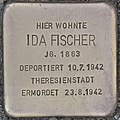
|
IDA FISCHER JG LIVED HERE . 1863 DEPORTED 07/10/1942 THERESIENSTADT MURDERED 08/23/1942 |
Richard Wagner-Gasse 5 |
Ida Fischer , née Wolff, was born on August 3, 1863 in Prague . She was the eldest daughter of Henriette and Leopold Wolff . Her father was a historian, wrote studies on the history of the Jews in the Austro-Hungarian monarchy and also made a contribution on Lessing and the Jews. Ida lost her parents very early, the mother died when Ida was 10 years old, the father three years later. She and her sister Helene were taken in by their uncle Joachim Wolff. On September 23, 1883 Ida married Friedrich Fischer, who came from Fürth and owned a paper mill. In 1884 the first child, Grete, was born. Three more children follow - Robert, Ernst and Trude. The paper mill went bankrupt. At the turn of the century the family moved to Vienna and opened a leather goods store on Kärntnerstraße. Ida also worked here until 1923. The sons Robert and Ernst both studied medicine, Robert became a cardiologist, Ernst a doctor in the Vienna municipal sanatorium in Ybbs on the Danube. Daughter Grete married Karl Klein in 1912 and lived with him in Mödling in the villa at Richard Wagner Gasse 5. The Fischer family also lived here for many months of the year with their daughter and son-in-law. Ida's husband Friedrich died in 1923 and is buried in the Jewish cemetery in Mödling. Ida stayed with her daughter even more often and looked after the three grandchildren Lisl, Peter and Hanna, especially since her youngest daughter Trude lived only two houses away. This had the lawyer Dr. Arthur Polacek married and with them the children Hans and Eva. After the annexation of Austria, the houses were expropriated and the families were forcibly relocated to Vienna. Ida was 75 years old at the time. Grete and Karl Klein were able to flee to Palestine on December 13, 1939. Trude and Arthur Polacek fled to the United States to see Arthur's brother, who had lived there since 1924. Robert Fischer was also able to flee to Palestine via Switzerland with his wife and two daughters. Ida had also applied for a visa to travel to Palestine, but did not receive it. Most recently she lived in a collective flat for Jews at Esslinggasse 15 in the 1st district of Vienna. On July 10, 1942, she was deported from Vienna to the Theresienstadt ghetto on Transport 30 (her number on the transport was 153). She was murdered there on August 23, 1942.
In 1956, on her first visit to Mödling after her escape, Grete Klein had her mother's name added to the tombstone of her late husband Friedrich Fischer. |

|
HELENE KAFKA JG LIVED HERE . 1894 EXECUTED 30.3.1943 VIENNA |
Sr. M. Restituta-Gasse 12 |
Helene Kafka , religious name Sr. Maria Restituta , was born on May 1st, 1894 in Hussowitz near Brno . She became a religious and nurse of the Franciscan Sisters of Christian Love . She refusedto remove crucifixes from the hospital rooms. This circumstance and two texts critical of the regime that she dictated were her undoing. After denunciation by a doctor, she was arrestedby the Gestapo in the operating theater on Ash Wednesday, February 18, 1942,and sentenced to death on October 29, 1942 for “ favoring the enemy and preparing for high treason ”. On March 30, 1943, she wasexecutedby beheading in the Vienna Regional Court .
She is considered a martyr within the Roman Catholic Church because she opposed the rulers during the Nazi era . Pope John Paul II beatified Sr. M. Restituta in 1998 . |

|
FERDINAND KARPEN JG LIVED HERE . 1880 DEPORTED 2.6.1942 MALY TROSTINEC MURDERED |
Friedrich Schiller Street 70 |
Ferdinand Karpfen was born on January 19, 1880 in Scheibbs . His parents were Bernhard and Franziska Karpfen. Ferdinand Karpfen first earned his living as an accountant for the BEKA shoe factory, and later he and his brother-in-law Hermann Rosenzweig opened a men's fashion store on Untere Hauptstrasse (at today's Hauptstrasse 3 or 5). With his wife Gisela, nee Rosenzweig, he had three sons: Erwin, Rudolf and Robert. Gisela Rosenzweig died before the National Socialists came to power. Ferdinand was deported from Vienna to Minsk on June 2, 1942 with Transport 24 Zug Da 205. He was murdered in the Maly Trostinez extermination camp .
Ferdinand Karpfen's son Robert died early. Son Rudolf emigrated to Israel with his wife Rosa, née Epstein. In 1947 their son Amos-Ferdinand was born. Rudolf worked as a tailor for almost 30 years and died in 1965. He left behind grandchildren and great-grandchildren. Erwin Karpfen survived the Nazi regime, stayed in Mödling and started a family here. His son Robert, Ferdinand's grandson, was politically active in Mödling and became vice mayor. |

|
ADOLF KOHN JG LIVED HERE . 1869 DEPORTED 1942 THERESIENSTADT 1942 TREBLINKA ? ? ? |
Enzersdorfer Strasse 44 |
Adolf Kohn was born in Graz on October 6, 1869. He was married to Rosa geb. Sprinzeles. The couple had six children, three sons and three daughters. Adolf Kohn was temple secretary until 1938, following his father-in-law in this position. Adolf Kohn and his wife Rosa were deported from Vienna Aspang to Theresienstadt on July 14, 1942 with Transport 31 (Adolf Kohn's prisoner number on the transport was 655). 953 of the 1001 people deported were older than 61 years. On July 15, 1942, the train arrived at Bohusovice station, from where people had to walk three kilometers to the camp. Most of the people on this transport died of starvation and disease in the summer. Adolf Kohn was transferred to Treblinka on September 21, 1942 , where he was murdered. His wife Rosa Kohn was also transferred to Treblinka two days later.
His son Norbert was also a victim of the Shoah. He stayed with his sick wife, who died of tuberculosis after 1939 and could no longer escape afterwards. His deportation took place before that of his parents. The other five children managed to escape to Australia or England. |

|
NORBERT KOHN JG LIVED HERE . 1903 DEPORTED 1941 OPOLE ? ? ? |
Enzersdorfer Strasse 44 |
Norbert Kohn was born on October 25, 1903 in Mödling. His parents were Adolf and Rosa Kohn. He had five siblings, two brothers and three sisters. He was married to Martha, nee Tauber. The couple lived in Vienna. He earned his living as a civil servant. His wife contracted TB, which she died of after 1939. Since he did not want to leave his sick wife, he missed the opportunity to escape, which his five siblings managed. On February 15, 1941, he was deported from Vienna to Opole on Transport 1. He did not survive the Shoah. Seven days after his deportation, he received permission to leave the country to Shanghai, and another two days later he received a visa to leave the United States.
His parents were deported a few months later and did not survive the Shoah either. |

|
ROSA KOHN JG LIVED HERE . 1872 DEPORTED 1942 THERESIENSTADT 1942 TREBLINKA DEAD 6.10.1942 |
Enzersdorfer Strasse 44 |
Rosa Kohn , nee Sprinzeles, was born on March 30, 1872 in Mödling. She was married to Adolf Kohn. The couple had six children, three sons and three daughters. The couple's last address was a collective flat for Jews at Pillersdorfgasse 10 in Vienna's 2nd district. On July 14, 1942, she and her husband were deported from Vienna Aspang to Theresienstadt on Transport 31 (Rosa Kohn's prisoner number on the transport was 656). 953 of the 1001 people deported were older than 61 years. The train arrived at Bohusovice station on July 15, 1942, and people had to walk three kilometers from here to the camp. Most of the people on this transport died of hunger and disease in the summer. Rosa Kohn was transferred to Treblinka on September 23, 1942, where she was murdered. Her husband was also transferred to Treblinka two days earlier.
Her son Norbert was also a victim of the Shoah. He stayed with his sick wife, who died of tuberculosis after 1939, and was unable to escape afterwards. His deportation took place before that of his parents. The other five children managed to escape to Australia or England. |
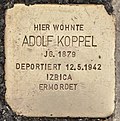
|
HERE LIVED ADOLF KOPPEL JG. 1879 DEPORTED 12.5.1942 IZBICA MURDERED |
Friedrich Schiller Street 76 |
Adolf Koppel was born on March 28, 1879 in Wiesen. He was the son of Josef and Lina Koppel. In Mödling he was a grain and feed dealer. He was married to Gisela, nee Hacker. The couple had a son - Josef. On May 12, 1942, Adolf Koppel and his wife Gisela were deported to Izbica. Neither of them survived the Shoah.
Son Josef survived. |

|
HERE LIVED GISELA KOPPEL GEB. HACKER JG. DEPORTED 1881 1942 IZBICA MURDERED |
Friedrich Schiller Street 76 |
Gisela Koppel , b. Hacker was born in Rust on March 3, 1881. Her parents were Samuel and Anna Hacker. She was married to the grain and feed dealer Adolf Koppel. The couple had a son - Josef. On May 12, 1942, Gisela Koppel and her husband Adolf were deported to Izbica. Neither of them survived the Shoah. Gisela's mother Anna and her brother Arnold were also murdered in a camp in Šabac in 1941 .
Son Josef survived. |

|
ALFRED MOSER JG LIVED HERE . 1879 DEPORTED 5.6.1942 TREBLINKA MURDERED |
Enzersdorfer Strasse 8 |
Alfred Moser was born on October 4, 1879 in Mödling. His mother was Henriette Moser, the father is unknown. Alfred Moser worked as a leather goods dealer, his shop was in Herzoggasse 3. He married Emma geb. Metzl, who came from Budweis . In 1936 he ran for the Cultural Council of the Israelitische Kultusgemeinde ( IKG) in Mödling, but could not win this vote. On June 5, 1942, he was deported from Vienna to the Izbica ghetto on Transport 25 . Alfred Moser did not survive the Shoah . |

|
ISIDOR NEURATH JG LIVED HERE . 1879 DEPORTED AUSCHWITZ MURDERED 08/10/1943 |
Axisaugasse 8 |
Isidor Neurath was born on March 29, 1879 in Mödling. His parents were Salomon and Regina Neurath. He is said to have run a wire mesh factory that he is said to have taken over from his father or his brother Adolf, who died in 1934. In 1939 he lived with his wife Marie in Ermsleben , where he earned his living as a mine worker. Isidor Neurath was murdered in Auschwitz on August 10, 1943. |

|
HERE LIVED ALFRED NOT HAUSER JG. 1887 DEPORTED 14.9.1942 MALY TROSTINEC ? ? ? |
Hauptstrasse 50 |
Alfred Nichtenhauser was born on December 2, 1887 in Lundenburg. He was a radio dealer in Mödling. On May 2, 1922, he married Anna Berger in a Jewish ceremony, which was the second marriage for his wife. This was to have an impact on further family life: in 1936 a court declared the divorce from the first husband invalid. In addition, Anna Nichtenhauser had two children - Hans and Elisabeth Nichtenhauser. After the annexation of Austria both children claimed that actually Anna's first husband Josef Berger, a non-Jew, her father would be because the sexual relationship was continued between the mother and Josef Berger because Alfred had not been to law enforcement in the area. Josef Berger denied this. After the annexation of Austria, Alfred could no longer work, the family was completely destitute. She probably tried this way, with the claim that the child's father was the gentile Berger, to receive financial support from the state. Both children were able to flee to England (Yorkshire) in 1939, the parents separated. Alfred Nichtenhauser last lived in Vienna at Weihburggasse 18 in the 1st district of Vienna. On September 14, 1942 he was deported from Vienna to the Maly Trostinez extermination camp on Transport 41 Zug Da 227, where he was shot on September 18, 1942.
Nothing further is known about the fate of the children. |

|
JULIUS PASTERNAK JG LIVED HERE . 1865 DEPORTED 13.8.1942 THERESIENSTADT MURDERED 12.3.1943 |
Hauptstrasse 27 |
Julius Pasternak was born on March 20, 1865 in Košice (Slovakia). On September 2, 1894, he married Friederike Frida, née Kowanitz. The couple had two children - Julie and Fritz Pasternak. Friederike died on February 18, 1898. Julius Pasternak was married to Margarethe, née Sommer, for the second time. Together they ran a printing company in Mödling. Until 1912 Pasternak was the editor of the Mödlinger Bezirksbote, an illustrated entertainment paper. Most recently he lived with his wife in a collective flat for Jews at Sterngasse 11 in Vienna's 1st district. On August 13, 1942, he and his wife were deported from Vienna to Theresienstadt on Transport 35 Zug Da 501 (his number on the transport was 312). Julius Pasternak was murdered on March 12, 1943, eight days before his 78th birthday. His wife did not survive the Shoah either, she was murdered in Auschwitz. |
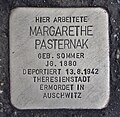
|
HERE LIVED MARGARETHE PASTERNAK GEB. SUMMER JG. 1880 DEPORTED 13.8.1942 THERESIENSTADT MURDERED IN AUSCHWITZ |
Hauptstrasse 27 |
Margarethe Pasternak , née Sommer, was born on February 15, 1880 in Tarnów (Poland). She was married to Julius Pasternak and worked with him in their joint print shop at Hauptstrasse 27. Julius Pasternak was also the editor of the Mödlinger Bezirksbote, an illustrated entertainment paper, until 1912 . Most recently she lived with her husband in a collective flat for Jews at Sterngasse 11 in Vienna's 1st district. On August 13, 1942, she and her husband were deported from Vienna to Theresienstadt on Transport 35 Zug Da 501 (their number on the transport was 313). On May 15, 1945 she was transferred from Theresienstadt to Auschwitz. Margarethe Pasternak was murdered in Auschwitz. Her husband did not survive either; he was murdered by the Nazi regime on March 12, 1943. |

|
HERE LIVED HENRIETTE SCHWARZ GEB. MERCHANT JG. 1884 DEPORTED 9/24/1942 THERESIENSTADT MURDERED IN AUSCHWITZ |
Demelgasse 33 |
Henriette Schwarz , née Kaufmann, was born on April 6, 1884 in Simontornya (Hungary). She was married to Moritz Schwarz, the couple had a daughter - Bertha. Most recently they lived in Vienna in a collective flat for Jews at 7 Körnergasse in Vienna's 2nd district. On September 24, 1942, Henriette and Moritz Schwarz were deported from Vienna to Theresienstadt on Transport 42 Zug Da 519 (their number on the transport was 633). Henriette Schwarz was transferred to Auschwitz on December 18, 1943. Henriette and Moritz Schwarz did not survive the Shoah .
Daughter Bertha Schwarz was able to flee to England on a Kindertransport in time. |
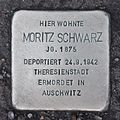
|
MORITZ SCHWARZ JG LIVED HERE . 1875 DEPORTED 9/24/1942 THERESIENSTADT MURDERED IN AUSCHWITZ |
Demelgasse 33 |
Moritz Schwarz was born on December 7, 1875 in Vagujelhy (Hungary). He was married to Henriette, née Kaufmann, and the couple had a daughter - Bertha. Moritz was a furniture dealer and second-hand dealer with a shop at Hauptstrasse 13 in Mödling. Most recently the couple lived in Vienna in a collective flat for Jews at Körnergasse 7 in Vienna's 2nd district. On September 24, 1942 Moritz and his wife Henriette were deported from Vienna to Theresienstadt on Transport 42, train Da 519. On December 18, he was transferred to Auschwitz. Moritz and Henriette Schwarz did not survive the Shoah ; both were murdered in Auschwitz. |
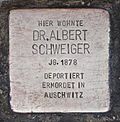
|
DR. ALBERT SCHWEIGER JG LIVED HERE . 1878 deported MURDERED IN AUSCHWITZ |
Enzersdorfer Strasse 6 |
Albert Schweiger was born on August 23, 1878 in Tapocany (Slovakia), his father was the Talmud scholar Jizchak Schweiger . In 1909 he married Emma, née Büchler. The couple had three children - Käthe, Ruth and Ernst. Dr. Albert Schweiger was a rabbi . During the First World War he was a field rabbi, from 1916 to 1921 he was rabbi in Kroměříž , then until 1926 in Jihlava . On August 15, 1926, he became district rabbi of the Israelite Religious Community ( IKG) Mödling. He taught Israelite religion at the BG Keimgasse grammar school in Mödling. These lessons could no longer be continued from October 15, 1938, he had to quit. Albert Schweiger and his wife last lived in Ferdinandstrasse 31/25 in the 2nd district of Vienna in a collective flat for Jews. On October 5, 1942, Albert Schweiger and his wife Emma Schweiger were deported from Vienna to the Maly Trostinez extermination camp on Transport 44, Zug Da 230 , where they were both murdered shortly after their arrival on October 9, 1942.
On October 26, 1938, his son Ernst (he was now a doctor) married Herta Freund. this was the last wedding that could take place in the Mödling synagogue. Ernst survived the Shoah and he reported to Yad Vashem about his father. |

|
ELZA SCHWEIGER JG LIVED HERE . 1880 DEPORTED 1942 MALY TROSTINEC DEAD 9.10.1942 |
Enzersdorfer Strasse 6 |
Emma Schweiger , nee Büchler, was born on November 10, 1878 in Breslau. She was married to Rabbi Albert Schweiger. The couple had three children - Käthe, Ruth and Ernst. Since 1926 her husband was the district rabbi of the Israelitische Kultusgemeinde (IKG) Mödling and also taught the Israelite religion in the grammar school BG Keimgasse. These lessons could not be continued from October 15, 1938, Albert Schweiger had to quit. Emma Schweiger last lived in Vienna at Ferdinandstraße 31/25 in the 2nd district of Vienna in a collective flat for Jews. On October 5, 1942, Emma and her husband were deported from Vienna to the Maly Trostinez extermination camp on Transport 44, Zug Da 230 , where both were murdered on October 9, 1942 shortly after their arrival. The inscription on the stumbling block is an error that can be traced back to an incorrect entry by a survivor in the Yad Vashem database.
On October 26, 1938, his son Ernst (he was now a doctor) married Herta Freund. this was the last wedding that could take place in the Mödling synagogue. Ernst survived the Shoah and he reported to Yad Vashem about his father. |

|
HERE LIVED EMANUEL TAPPET JG. DEPORTED 1886 1941 ŁODZ ? ? ? |
Klostergasse 8 |
Emanuel Stössel was born on May 24, 1886 in Lockenhaus. His parents were Wolf and Sofie Stössel. He was married to Valerie, nee Breuer. The couple had at least one daughter - Sophie. He earned his living as a grocer and merchant. In 1932 he became a board member of the Israelitische Kultusgemeinde (IKG) Mödling. In Mödling he lived with his wife at Klostergasse 8, after the annexation of Austria they had to leave their apartment and came to a collective apartment for Jews in Tandelmarktgasse 8 in Vienna's 2nd district. On October 19, 1941, he and his wife were deported from Vienna to Litzmannstadt (Łódź) on Transport 7, Train Da 5 . Emanuel Stössel and his wife did not survive the Shoah .
Sophie survived the Shoah and she reported to Yad Vashem. |

|
VALERIE STÖSSEL JG LIVED HERE . DEPORTED 1887 1941 ŁODZ ? ? ? |
Klostergasse 8 |
Valerie Stössel , née Breuer, was born on December 28, 1887 in Berndorf. She was married to Emanuel Stössel, a grocer and merchant who was a member of the board of the Israelitische Kultusgemeinde (IKG) Mödling from 1932 . The couple had at least one daughter - Sophie. In Mödling she lived with her husband at Klostergasse 8, after the annexation of Austria they had to leave their apartment and came to a collective apartment for Jews in Tandelmarktgasse 8 in Vienna's 2nd district. On October 19, 1941, she and her husband were deported from Vienna to Litzmannstadt (Łódź) on Transport 7, Train Da 5 . Valerie Stössel and Emanuel did not survive the Shoah .
Sophie survived the Shoah and she reported to Yad Vashem. |

|
PAULINE STÖSSEL GEB. LIVED HERE. LÖWENFELD JG. 1885 DEPORTED 2.6.1942 MALY TROSTINEC MURDERED |
Wiener Strasse 33b |
Pauline Stössler , née Löwenfeld, was born on November 2, 1885 in Vienna. On July 29, 1907, she married Siegfried Stössler, an owner of a wine shop in Vienna (Stefaniegasse 2). The couple had two children - Alice Rachel (born May 22, 1909) and Carl Samuel. The family lived in Mödling at Wienerstraße 33b. Her husband and father Siegfried Stössler died in 1935. Pauline last lived in a collective flat for Jews in Vienna's 2nd district at Josefinengasse 6. On June 2, 1942, Pauline Stössler was deported from Vienna to the Maly Trostinez extermination camp in Transport 24, Zug Da 205 . She did not survive the Shoah . |

|
HERE LIVED ADELE TAUSSIG GEB. POLLAK JG. 1885 DEPORTED RIGA ? ? ? |
Pfarrgasse 8 |
Adele Taussig , nee Pollak, was born on February 16, 1885 or 1886 in Vienna or Kuttenberg. She was married to the lawyer Konrad Taussig. The couple had at least one child - daughter Renee. The family lived in Mödling in the Dr. Seipelgasse 8 (today Pfarrgasse 8). Most recently she lived in Vienna at Wilhelm-Exner-Gasse 15 in Vienna's 9th district, presumably a collective flat for Jews. On April 27, 1942, Adele was deported from Vienna to Riga on Transport 18. Her husband had been deported on February 6, 1942. Adele Taussig and Konrad Taussig did not survive the Shoah .
Daughter Renee survived, through her the report was made to Yad Vashem . |

|
KONRAD TAUSSIG JG LIVED HERE . 1883 DEPORTED RIGA ? ? ? |
Pfarrgasse 8 |
Konrad Taussig is said to have been born in Vienna on July 29, 1882, but his daughter Renee gives September 5, 1883 as her date of birth. He was a lawyer and married to Adele Taussig geb. Pollak. The couple had at least one daughter, Renee. The family lived in Mödling in the Dr. Seipelgasse 8 (today Pfarrgasse 8). Konrad Taussig last lived in Vienna at Wilhelm-Exner-Gasse 13 in Vienna's 9th district, presumably a collective flat for Jews. Konrad Taussig was deported to Riga on February 6, 1942, and his wife Adele Taussig to Riga on April 27, 1942. Neither of them survived the Shoah .
Daughter Renee survived, through her the report was made to Yad Vashem . |

|
EMIL ARTHUR TRITSCH JG LIVED HERE . 1887 DEPORTED 20.5.1942 MALY TROSTINEC MURDERED 26.5.1942 |
Friedrich Schiller-Strasse 4 |
Emil Arthur Tritsch was born in Vienna on August 27, 1877. He was a bank clerk and married to Franziska geb. Müller, also called Fanny , who owned a delicatessen shop at Friedrich Schiller-Strasse 4 in Mödling. The couple had a daughter - Susanne. Most recently, the family lived in a collective flat for Jews at Czerningasse 7 in Vienna's 2nd district. On May 20, 1942, Emil Arthur Tratsch, his wife and daughter, were deported from Vienna to Minsk on Transport 22 Zug Da 203. On the day of arrival, May 26, 1942, Arthur Emil Tritsch was driven to a forest (Blagovshchina) near the Maly Trostinez extermination camp and shot in front of a prepared pit. His wife and daughter were also shot there. |

|
FRANZISKA TRITSCH GEB. LIVED HERE MÜLLER JG. 1884 DEPORTED 20.5.1942 MALY TROSTINEC MURDERED 26.5.1942 |
Friedrich Schiller-Strasse 4 |
Franziska Tritsch b. Müller, also called Fanni , was born on October 1st, 1884 in Mödling. She had a delicatessen shop at 4 Friedrich Schiller Strasse in Mödling. She was married to Emil Arthur Tritsch. The couple had a daughter - Susanne. Most recently, the family lived in a collective flat for Jews at Czerningasse 7 in Vienna's 2nd district. On May 20, 1942, Franziska Tritsch, her husband and daughter were deported from Vienna to Minsk on Transport 22 Zug Da 203. On the day of arrival, May 26, 1942, Franziska Tritsch was driven to a forest (Blagovshchina) near the Maly Trostinez extermination camp and shot in front of a previously prepared pit. Her husband and daughter were also shot there. |

|
SUSANNE TRITSCH JG LIVED HERE . 1894 DEPORTED 20.5.1942 MALY TROSTINEC MURDERED 26.5.1942 |
Friedrich Schiller-Strasse 4 |
Susanne Tritsch was born on February 9, 1923 in Mödling. Her parents were Emil and Franziska Tritsch. Her mother had a delicatessen shop at Friedrich Schiller-Strasse 4 in Mödling. Most recently, the family lived in a collective flat for Jews at Czerningasse 7 in Vienna's 2nd district. On May 20, 1942, Susanne Tritsch and her parents were deported from Vienna to Minsk on Transport 22 Zug Da 203 (Susanne's number on the transport was 752). On the day of arrival, May 26, 1942, Susanne Tritsch was driven into a forest (Blagovshchina) near the Maly Trostinez extermination camp and shot in front of a previously prepared pit. Her parents were also shot there that day. |

|
FERDINAND TSCHÜRTZ JG LIVED HERE . 1905 ARRESTED 17.6.1938 KZ DACHAU MURDERED 19.1.1939 KZ BUCHENWALD |
Neudorfer Strasse 8 |
Ferdinand Tschürtz was born on June 15, 1905. He was politically active and high official of the Socialist Students , the Socialist Workers' Youth , the SDAP and the Republican Defense Corps . On July 22, 1934 he was because of his contacts with the Revolutionary Socialists into detention camp Wöllersdorf brought. In 1935 Tschürtz took part in the Brno Reich Conference, was therefore arrested again and sentenced to five years in heavy dungeon with two hard camps a month for high treason. Thanks to an amnesty, he was released early and has already obtained emigration papers, but was arrested by the Gestapo in 1938 on a farewell visit to friends . On June 17, 1938, Ferdinand Tschürtz was deported to the Dachau concentration camp , from where he was transferred to the Buchenwald concentration camp on September 23, 1938 . He was murdered by the Nazi regime on January 19, 1939. |

|
HERE LIVED IRMA Weltsch GEB. KOHN JG. 1899 ESCAPE TO DEATH 7.10.1938 |
Friedrich Schiller Street 77 |
Irma Weltsch born Kohn was born on January 7, 1899 in Mödling. She had a general store at 77 Friedrich Schiller-Strasse. She was married to Hugo Weltsch for the second time. She committed suicide on October 7, 1938. |
Neunkirchen
The following stumbling blocks were laid in the city of Neunkirchen on the following days:
- July 5, 2011: Stockhammergasse 11 and 15, Triesterstraße 23, Wienerstraße 11
- March 26, 2012: Triesterstraße 10, Wiener Straße 8 and 13
- April 23, 2013: Bahnstrasse 24, 28 and 39, Franz Krinninger Gasse 1, Wienerstrasse 42
- July 5, 2014: Hohe Wand Gasse 16/18, Meranergasse 9, Triesterstraße 23 (Rosa Kolár)
| image | inscription | Location | Life |
|---|---|---|---|

|
CHAJE FISCH JG LIVED HERE . 1883 DEPORTED 19.10.1941 ŁODZ MURDERED |
Triesterstraße 10 |
Chaje Fisch , nee Zilberberg, was born on February 3, 1883 in Frysztak. She lived in Neunkirchen at Triesterstraße 10. She was married to Chaje David Fisch. The couple had six children. After the annexation of Austria, she had to leave this apartment and came to a collective apartment for Jews in Förstergasse 4/5 in the 2nd district of Vienna. On October 19, 1942, she was deported with her husband and at least one of her children (Rosa, born 1915) on Transport 7, train Da 5 from Vienna to the Litzmannstadt ghetto (Łódź). Chaje Fisch did not survive the Shoah .
One of their six children survived - Meir Fisch reported his family to Yad Vashem . |

|
HERE LIVED DAVID Chaje FISH JG. 1875 DEPORTED 19.10.1941 ŁODZ MURDERED |
Triesterstraße 10 |
David Chaje Fisch was born on August 12, 1878. He was married to Chaje Fisch. The couple had six children. He earned the money for the family as a peddler . After the annexation of Austria he had to leave this apartment and came to a collective apartment for Jews at Förstergasse 4/5 in the 2nd district of Vienna. On October 19, 1942, he and his wife and at least one of his children (Rosa, born 1915 ) were deported from Vienna to the Litzmannstadt ghetto (Łódź) on Transport 7, train Da 5 . Chaje David Fisch did not survive the Shoah .
One of his six children survived - Meir Fisch reported his family to Yad Vashem . |

|
JOEL FISCH JG LIVED HERE . 1940 DEPORTED 6.5.1942 MINSK MURDERED |
Triesterstraße 10 |
Joel Fisch was born on January 14, 1940 in Vienna. In Vienna, he last lived with his mother Marie Fisch (born 1915) in the 2nd district of Vienna at Franz Hochedlingergasse 23. On May 6, 1942, at the age of 2½, he and his mother were transported by Transport 19, Zug Da 201 from Vienna deported to Minsk (his number on the transport was 706). The train reached its destination on May 11, 1942. 1000 people were on this transport and were driven into a forest (Blagovshchina) near the Maly Trostinez extermination camp, where they were shot in front of prepared pits. Joel Fisch and his mother were also murdered this way. |

|
MARIA FISCH LIVED HERE DEPORTED 6.5.1942 MINSK MURDERED |
Triesterstraße 10 |
Maria Fisch , née Pollock, was born on April 29, 1915 in Siegendorf. She lived in Neunkirchen at Schießstättgasse 33. She was married to Leo Fisch. After the annexation of Austria, she had to leave this apartment and came to a collective apartment for Jews in Vienna's 2nd district (Franz Hochedlingergasse 23). She lived there with her son Joel Fisch, who was born on January 14, 1940. On May 6, 1942, she and her son were deported from Vienna to Minsk on transport 19, train Da 201 (her number on the transport was 705). The train reached its destination on May 11, 1942. 1000 people were on this transport and were driven into a forest (Blagovshchina) near the Maly Trostinez extermination camp, where they were shot in front of prepared pits. Maria Fisch and her son were also murdered in this way. |

|
ROSA FISCH JG LIVED HERE . 1915 DEPORTED 19.10.1941 ŁODZ MURDERED |
Triesterstraße 10 |
Rosa Fisch was born on February 16, 1915 in Neunkirchen. She was the daughter of Chaje Fisch and Chaje David Fisch. She was one of six children in the family. She lived in Neunkirchen at Triesterstraße 10. After the annexation of Austria, the family had to leave this apartment and they came to a collective apartment for Jews in Förstergasse 4/5 in the 2nd district of Vienna. In Vienna she last lived with her parents in a collective flat for Jews in Förstergasse 4/5 in the 2nd district of Vienna. On October 19, 1942, she and her parents were deported from Vienna to the Litzmannstadt ghetto (Łódź) on Transport 7, train Da 5 . Rosa Fisch did not survive the Shoah .
Her brother Meir Fisch was able to survive and he registered his family with Yad Vashem . |

|
SAMUEL FISCH JG LIVED HERE 1886 DEPORTED AUSCHWITZ MURDERED |
Triesterstraße 10 |
Samuel Fisch was born on February 21, 1886 in Neunkirchen. It is known that he last lived in Vienna at Keplerplatz 1 in Vienna's 10th district. He was deported from Mechelen to Auschwitz on January 15, 1943 . Samuel Fisch did not survive the Shoah . |

|
SIEGMUND FISCH FISH LIVED HERE UNKNOWN |
Triesterstraße 10 |
Siegmund Fisch is not aware of anything. |

|
HERE LIVED ELSA GERSTL JG. 1903 DEPORTED 1942 MURDERED MALY-TROSTINEC |
Bahnstrasse 28 |
Elsa Gerstl was born on November 28, 1903 in Neunkirchen. She was the daughter of Moritz and Hanni Gerstl and had five siblings. Elsa lived in Neunkirchen at Bahnstrasse 28. After the annexation of Austria, she had to leave this apartment and she came to a collective apartment for Jews at Kohlmessergasse 6 in Vienna's 1st district. On August 31, 1942, she was deported from Vienna to the Maly Trostinez extermination camp on Transport 39, Zug Da 225 , where Elsa Gerstl was murdered on September 4, 1942. |

|
KAROLINE GERSTL JG LIVED HERE . DEPORTED 1896 1942 MURDERED RIGA |
Bahnstrasse 24 |
Karoline Gerstl , née Kohn, was born on October 8, 1896 in Mattersburg. She was married to Oskar Gerstl. The couple lived in Neunkirchen at Bahnstrasse 24. In Vienna, they last lived in a collective flat for Jews at Rembrandtstrasse 25 in Vienna's 2nd district. On February 6, 1942, she was deported from Vienna to Riga on Transport 16 (her number on the transport was 106). Karoline Gerstl did not survive the Shoah . |

|
HERE LIVED KAROLINE GERSTL GEB. BAUER JG. 1880 ESCAPE TO DEATH VIENNA June 19, 1940 |
Wienerstrasse 42 |
Karoline Gerstl , nee Bauer, was born in Strasbourg on August 28, 1880. She was married to Moritz Gerstl, the couple lived in Neunkirchen at Wienerstraße 42. After the annexation of Austria, she had to leave this apartment and she came to a collective apartment for Jews at Oberen Donaustraße 85 in Vienna's 2nd district. On June 19, 1940, she committed suicide by hanging. |

|
MORITZ GERSTL JG LIVED HERE . DEPORTED 1885 1941 MURDERED ŁODZ |
Wienerstrasse 42 |
Moritz Gerstl was born in Vienna on April 5, 1885. He was a businessman and married to Hanni, née Stössel. He had six children with her. Hanni died in 1935. Then he married Karoline, nee Bauer. The couple lived in Neunkirchen at Wienerstraße 42. After the annexation of Austria, he had to leave this apartment and he came to a collective apartment for Jews at Leopoldgasse 22 in Vienna's 2nd district. On October 19, 1941, he was deported from Vienna to the Litzmannstadt ghetto (Łódź) on Transport 7, Train Da 5 . Moritz Gerstl was murdered here on April 30, 1942.
Moritz Gerstl's heirs received the property back at Wienerstraße 42 in 1951. |

|
OSKAR GERSTL JG LIVED HERE . DEPORTED 1885 1942 MURDERED RIGA |
Bahnstrasse 24 |
Oskar Gerstl was born on November 9, 1885 in Neunkirchen. Here he lived at Bahnstrasse 24 with his wife Karoline, née Kohn. He was a trader in textiles, linen and clothing. On May 12, 1938, his apartment was stormed and Oskar Gerstl was accused of illegal business and insurance fraud. His property was confiscated. He came to a collective flat for Jews at Rembrandtstrasse 25 in Vienna's 2nd district. On February 6, 1942, he and his wife were deported from Vienna to Riga on Transport 16 (his number on the transport was 105). Oskar Gerstl and Karoline Gerstl did not survive the Shoah . |

|
EMMA KOHN JG LIVED HERE . DEPORTED 1873 1942 THERESIENSTADT MURDERED |
Wienerstraße 11 |
Emma Kohn was born on April 28, 1873 in Wiener Neustadt. She lived in Neunkirchen at Wiener Straße 11. She was married to Wilhelm Kohn, who owned the Rodler company. After the annexation of Austria, her entire property was confiscated, her husband's company was Aryanized and she had to leave her apartment. She came to a collective flat for Jews at Hollandstrasse 14 in Vienna's 2nd district. On June 20, 1942, she was deported from Vienna to the Theresienstadt concentration camp on Transport 28 (her number on the transport was 601). On September 19, 1942, she was transferred to the Treblinka extermination camp , where Emma Kohn was murdered. |

|
KATHARINA KOHN JG LIVED HERE . UNKNOWN DEPORTED 1942 KIELCE ? ? ? |
Wienerstraße 11 |
Katharina Kohn , née Löwy, was the daughter of Simon and Maria Löwy. She was one of eleven children. Her parents owned a used clothes shop at Hauptstrasse 15 in Neunkirchen. Katharina Kohn was deported in 1942, according to the inscription on the stone to Kielce, according to another source she was deported to Auschwitz and murdered there. |
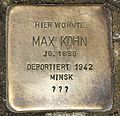
|
MAX KOHN JG LIVED HERE . DEPORTED 1880 1942 MINSK ? ? ? |
Wienerstraße 11 |
Max Kohn was born on August 26, 1880 in Neunkirchen. He was a master tailor and lived at Wienerstraße 11 in Neunkirchen. After the annexation of Austria his entire property was confiscated and his business aryanized . He had to leave his apartment and he came to a collective apartment for Jews at Hollandstrasse 14 in Vienna's 2nd district. On June 2, 1942, he was deported from Vienna to the Maly Trostinez extermination camp. He had already paid the Reich Flight Tax. Max Kohn was murdered in Maly Trostinez. |

|
ROSA KOHN JG LIVED HERE . DEPORTED 1877 1942 MINSK ? ? ? |
Wienerstraße 11 |
Rosa Kohn was born on June 20, 1874 in Neunkirchen (the inscription on the stone is incorrect). She lived in Neunkirchen at Wienerstraße 11. After the annexation of Austria she had to leave this apartment and she came to a collective apartment for Jews at Hollandstraße 14 in the 2nd district of Vienna. On June 2, 1942, she was deported from Vienna to Minsk on Transport 24, Train Da 205. Rosa Kohn did not survive the Shoah . |

|
HERE LIVED ROSA KOLÁR JG. 1913 ADMITTED SANCTUARY KLOSTERNEUBURG GUGGING MURDERED 8.2.1944 |
Triesterstraße 23 |
Rosa Kolár was born in 1913. She was a victim of the Aktion T4 euthanasia program . She was declared underage and admitted to the Gugging Sanatorium, where she was murdered on February 8, 1944. |
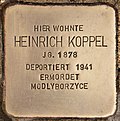
|
HEINRICH KOPPEL JG LIVED HERE . DEPORTED IN 1878 1941 MURDERED MODLYBORZYCE |
Bahnstrasse 39 |
Heinrich Koppel was born on February 6, 1878 in Neunkirchen. He lived here at Bahnstrasse 39 with his wife. He earned his living as a businessman. He had shares in a company for machine manufacturing and iron wholesale. After the annexation of Austria his entire property was confiscated and his business aryanized . He had to leave his apartment and he ended up in a collective apartment for Jews in Favoritenstrasse 115 in Vienna's 10th district. On March 5, 1941, he was deported from Vienna to Modliborzyce on Transport 4 . Heinrich Koppel did not survive the Shoah . |

|
SIMON LÖWY JG LIVED HERE . 1854 DEPORTED 1942 IZBICA DEAD ON TRANSPORT |
Wienerstrasse 13 |
Simon Löwy was born on April 1, 1854. He was the eldest son of Isak and Regina Löwy, who had four children. He was married to Maria, née Lipschitz. He moved with her to Neunkirchen and ran a second-hand clothing store here at Hauptstrasse 15. The couple had eleven children. Simon got involved in Neunkirchen for the interests of the religious community and was a founding member of the Chewra Kadischa . On April 14, 1938 at midnight there was a house search at the Simon Löwy company (clothing trade), the property was confiscated and the property was Aryanized . The family was expelled to Vienna. Simon died in Vienna. The information on the stone does not seem correct, it seems to have been confused with Simon Löwy, who was born on November 14th, 1899. |

|
HERMINE MAIER JG LIVED HERE . DEPORTED 1880 1941 ŁODZ ? ? ? |
Triesterstraße 23 |
Hermine Maier was born on March 5, 1880. She lived in Neunkirchen at Triesterstraße 23. During the house search at Löwy & Söhne on April 14, 1938, she was arrested but released. Her entire property was Aryanized , the house in Triesterstraße had to be sold to the municipality and she was moved to a collective flat for Jews at Rotensterngasse 13 in Vienna's 2nd district. On May 15, 1942, she was deported from Vienna to Izbica on Transport 21 . Hermine Maier did not survive the Shoah . |
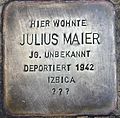
|
JULIUS MAIER JG LIVED HERE . UNKNOWN DEPORTED 1941 IZBICA ? ? ? |
Triesterstraße 23 |
Julius Maier was born on November 17, 1883 in Neunkirchen. Until the annexation of Austria he lived here at Triesterstraße 23. The house was Aryanized and he came to a collective apartment for Jews at Krummbaumgasse 1 in the 2nd district of Vienna. On April 9, 1942, he was deported from Vienna to Izbica . Julius Maier did not survive the Shoah . |

|
MAX MAIER JG LIVED HERE . DEPORTED 1882 1941 RIGA ? ? ? |
Triesterstraße 23 |
Max Maier was born in Neunkirchen on December 16, 1872 (the date on the stone is an error). He was the owner of a general store. On May 15, 1938 his business was stormed, there were confiscations, he had to forcibly sell the business and the house and he was forced to donate 8,000 Reichsmarks to Winterhilfe. On January 11, 1942, Max Maier was deported to Riga; he did not survive the Shoah . |
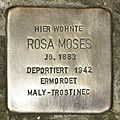
|
HERE LIVED ROSA MOSES JG. DEPORTED 1883 1942 MURDERED MALY-TROSTINEC |
Franz Krinninger Gasse 1 |
Rosa Moses was born on February 8, 1883 in Gloggnitz. She lived in Neunkirchen at Krinninger Gasse 1. She was a trader. After the annexation of Austria, all of their property was confiscated and their business was Aryanized . She came to a collective flat for Jews at Große Pfarrgasse 2 in Vienna's 2nd district. On June 2, 1942, she was deported from Vienna to the Maly Trostinez extermination camp on Transport 24, Zug Da 205 (her number on the transport was 144). Rosa Moses did not survive the Shoah . |
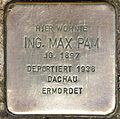
|
ING LIVED HERE . MAX PAM JG. DEPORTED IN 1897 1938 DACHAU MURDERED |
Stockhammergasse 11 |
Max Pam was born on September 16, 1897 in Neunkirchen. He was married to Cäcilie Pam, née Ambor, and managed the company “M. Pam's sons, mechanical paper sleeves and Spulenfabrik ”, the largest Jewish company in Neunkirchen and one of the larger industrial companies here with 132 employees. The company was founded by Heinrich and Samuel Pam, both died in 1925, and since then it has been owned by the two widows Adele and Stefanie Pam. Max Pam was a grandson of the founders. In 1938 the company was Aryanized . Max came to Vienna and lived at Herrengasse 6 in Vienna's 1st district. He was arrested during the Reichskristallnacht and deported to Dachau on November 11, 1938, where he was murdered on December 13, 1938.
His mother and aunt were able to flee Austria in 1939 and find safety. |

|
BERTHOLD PREIS JG LIVED HERE . DEPORTED 1889 1942 AUSCHWITZ MURDERED October 19, 1944 |
Hohe Wand Gasse 16/18 |
Bernhard Berthold Preis was born on April 2, 1889 or 1899 in Neunkirchen. After the annexation of Austria he had to leave Neunkirchen and he last lived in Vienna at Custozzagasse 1 in the 3rd district of Vienna.
On May 25, 1943, he was deported from Vienna to Theresienstadt, from where he was transferred to Auschwitz on October 19, 1944 , where Berthold Preis was murdered. |

|
GISELA PREIS JG LIVED HERE . 1890 DEAD ON KLADOVO TRANSPORT CONCENTRATION CAMP SAJMIŠTE NEAR BELGRADE |
Hohe Wand Gasse 16/18 |
Gisela Preis was born on November 15, 1890 in Willendorf near Neunkirchen. After the annexation of Austria she had to leave Neunkirchen, the house was sold beforehand, and she also had to sell the jewelry. She then lived in Vienna at Haidgasse 5 in the 2nd district of Vienna. In autumn 1939 Gisela Preis tried to flee to Palestine with the Kladovo transport , the ships were stopped. First in Kladovo, later the refugees were brought to Šabac. All under 17-year-olds on this transport could be brought to Palestine by ship in March 1941. All others were interned in a camp. Gisela Preis came to the Sajmište concentration camp and was gassed there in a special truck. |
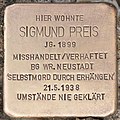
|
SIGMUND PRICE JG LIVED HERE . 1899 MISTRADED / ARRESTED BG WR, NEUSTADT SUICIDE BY HANGING 05/21/1938 CIRCUMSTANCES NEVER DETECTED |
Hohe Wand Gasse 16/18 |
Sigmund Preis (also Siegmund) was born on June 22, 1899. He was married and made a living as a scrap iron dealer. After the annexation , he tried to sell all his property in time and to flee, but he was arrested on his company premises, where he was hiding. In custody he was mistreated by SS men. On May 21, 1938, Siegmund Preis was found hanged in the district court of Wiener Neustadt. His funeral was initially the last to take place in the Neunkirchen Jewish cemetery . After 1945 three more burials took place here. |
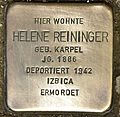
|
HELENE REININGER GEB. LIVED HERE KARPEL JG. DEPORTED 1886 1942 IZBICA MURDERED |
Stockhammergasse 15 |
Helene Reininger , née Karpel, was born in Vienna on October 23, 1886, according to her niece in Ostrava. She lived in Neunkirchen at Stockhammergasse 15 with her husband Ignaz Reininger. Ignaz and his brother Heinrich ran a department store. After the annexation , the couple were forced to sell their house, which was acquired by the Evangelical Church, which turned it into a rectory. The proceeds of 18,000 Reichsmarks were used in part to repay mortgages, the rest of the sum went to the property transfer office of the Nazi Ministry of Economics and Labor, these were blocked accounts and Helene and Ignaz did not receive any money. They came to Vienna and lived there at Fugbachgasse 3 in Vienna's 2nd district. On May 15, 1942, Helene and her husband were deported from Vienna to Izbica on Transport 21. Helene Reininger did not survive the Shoah .
In 1960 restitution proceedings were initiated for the family home, but the Evangelical Church at the time claimed that the sale was voluntary. A settlement is reached and the Evangelical Church pays 35,000 shillings to collection point A for unclaimed Jewish property. In 2003 her niece Gertrude Bibring asked for compensation for the house, which was initially rejected by the pastor Herwig Sturm, but in 2004 he offered Gertrude Bibring a payment of 6,000 euros, which she refused. It was only through his successor Michael Bünker that an appropriate compensation payment was made in 2011. |

|
HERE LIVED IGNAZ REININGER JG. DEPORTED 1880 1942 IZBICA MURDERED |
Stockhammergasse 15 |
Ignaz Reininger was born on November 30, 1880 in Neunkirchen. He was married to Helene Reininger, née Karpel, and the couple had their house at Stockhammergasse 15. Ignaz was a trained watchmaker and ran a department store with his brother Heinrich. After the annexation , the couple were forced to sell their house, which was acquired by the Evangelical Church, which turned it into a rectory. The proceeds of 18,000 Reichsmarks were used in part to repay mortgages, the rest of the sum went to the property transfer office of the Nazi Ministry of Economics and Labor. These were blocked accounts and Ignaz and Helene received no money. They came to Vienna and lived there at Fugbachgasse 3 in Vienna's 2nd district. On May 15, 1942, Ignaz and his wife were deported from Vienna to Izbica on Transport 21. Ignaz Reininger did not survive the Shoah .
In 1960 restitution proceedings were initiated for the family home, but the Evangelical Church at the time claimed that the sale was voluntary. A settlement is reached and the Evangelical Church pays 35,000 shillings to collection point A for unclaimed Jewish property. In 2003 her niece Gertrude Bibring asked for compensation for the house, which was initially rejected by the pastor Herwig Sturm, but in 2004 he offered Gertrude Bibring a payment of 6,000 euros, which she refused. It was only through his successor Michael Bünker that an appropriate compensation payment was made in 2011. |

|
HERE LIVED MARTHA REININGER JG. 1928 DEPORTED 1942 KLADOVOTRANSPORT SAJMISTS MURDERED |
Wiener Strasse 8 |
Martha Reininger was born on April 19, 1928 in Vienna. In autumn 1939 she tried to flee to Palestine with the Kladovo transport , the ships were stopped. First in Kladovo, later the refugees were brought to Šabac. All under 17-year-olds on this transport could be brought to Palestine by ship in March 1941. All others were interned in a camp. Martha Reisinger came to the Sajmište concentration camp and was gassed there in a special truck.
Her sister Gertrude Reininger, married Bibring, was able to flee to England on a transport in 1939, and her parents also survived in a home in Budapest disguised as deaf people. |

|
ALICE SPIEGEL JG LIVED HERE . DEPORTED 1928 1942 THERESIENSTADT MURDERED 9/10/1942 |
Meranergasse 9 |
Alice Spiegel was born on July 28, 1928 in Tarnow. Her parents were Michael and Elsa Spiegel. She lived in Neunkirchen at Meranergasse 9. After the annexation , the Spiegel family had to leave the house and they lived in a collective apartment for Jews at Vereinsgasse 25 in Vienna's 2nd district. On September 10, 1942, Alice and her family were deported from Vienna to Theresienstadt on Transport 40, Zug Da 513 (her number on the transport was 741). Alice Spiegel did not survive the Shoah . According to the inscription on the stone, Alice Spiegel would have been murdered on September 10, 1942, but the transport did not arrive in Theresienstadt until September 11, 1942. |

|
HERE LIVED ELSA SPIEGEL JG. 1903 DEPORTED 1942 THERESIENSTADT MURDERED 9/10/1942 |
Meranergasse 9 |
Elsa Spiegel , née Jaul, was born in Neunkirchen on September 23, 1903. She lived in Neunkirchen with her husband Michael Spiegel at Meranergasse 9. The couple had at least two daughters - Gerta (born 1931) and Alice (born 1928). After the annexation , the Spiegel family had to leave the house and they lived in a collective flat for Jews at Vereinsgasse 25 in Vienna's 2nd district. On September 10, 1942, Elsa and her family were deported from Vienna to Theresienstadt on Transport 40, Zug Da 513 (her number on the transport was 740). Elsa Spiegel did not survive the Shoah . According to the inscription on the stone, Elsa Spiegel would have been murdered on September 10, 1942, but the transport did not arrive in Theresienstadt until September 11, 1942. |

|
GERTA SPIEGEL JG LIVED HERE . 1931 DEPORTED 1942 THERESIENSTADT MURDERED 9/10/1942 |
Meranergasse 9 |
Gerta Spiegel was born on April 5, 1931 in Neunkirchen. Her parents were Michael and Elsa Spiegel. After the annexation , the Spiegel family had to leave the house and they lived in a collective flat for Jews at Vereinsgasse 25 in Vienna's 2nd district. On September 10, 1942, Gerta and her family were deported from Vienna to Theresienstadt on Transport 40, Zug Da 513 (her number on the transport was 742). Gerta Spiegel did not survive the Shoah . According to the inscription on the stone, Gerta Spiegel would have been murdered on September 10, 1942, but the transport did not arrive in Theresienstadt until September 11, 1942. |

|
MICHAEL SPIEGEL JG LIVED HERE . DEPORTED 1887 1942 THERESIENSTADT MURDERED 9/10/1942 |
Meranergasse 9 |
Michael Spiegel was born on January 18, 1887. He was married to Elsa Spiegel and made a living as a textile dealer. The couple had at least two daughters - Gerta (born 1931) and Alice (born 1928). After the annexation , the Spiegel family had to leave the house and they lived in a collective flat for Jews at Vereinsgasse 25 in Vienna's 2nd district. On September 10, 1942, Michael and his family were deported from Vienna to Theresienstadt on Transport 40, Zug Da 513 (his number on the transport was 739). Michael Spiegel did not survive the Shoah . According to the inscription on the stone, Michael Spiegel would have been murdered on September 10, 1942, but the transport did not arrive in Theresienstadt until September 11, 1942. |
Pitten
The following stumbling blocks were laid in the market town of Pitten on August 7, 2018:
| image | inscription | Location | Life |
|---|---|---|---|

|
ROSA REBECCA ABELES JG. DEPORTED 1866 1942 THERESIENSTADT MURDERED 1942 TREBLINKA |
On the Schmelz 62 (in front of the new middle school) |
Rosa Rebecca Abeles was born on June 28, 1866 as the daughter of the merchant Rudolf Abeles and his wife Charlotte (née Moses). The family moved to Pitten around 1878, where their youngest son Isidor was born on February 17, 1878. The eight children of the family attended school in Pitten. Rosa Rebecca Abeles was single and lived on Bahnhofstrasse in Pitten. On October 23, 1939, she had to move to the already Aryanized house of the Jewish businessman Johann Jaul at Wiener Neustädter Strasse 18. On December 12 of the same year she was transferred to the Jewish old people's home at Wasnergasse 33 in Vienna-Brigittenau . After the old people's home was closed in October 1941, Rosa Rebecca Abeles came to the old people's home in Alxingergasse 97-103 in Vienna-Favoriten, which the Nazis referred to as a “sorting home” . The residents of this home only stayed there for a few months until they were deported to the Nazi extermination camps. Rosa Rebecca Abeles was deported to the Theresienstadt concentration camp on July 22, 1942 and transferred to Treblinka on September 21 of the same year . She did not survive. |

|
JOHANN JAUL JG. DEPORTED 1875 1941 RIGA MURDERED |
On the Schmelz 62 (in front of the new middle school) |
Johann Jaul was born on April 23, 1875 in Seebenstein as the son of Rosa and Samuel (Salomon) Jaul (businessman in Seebenstein). He settled in Pitten, where he ran a general store at Wiener Neustädter Straße 18 . The Jaul family originally came from Kobersdorf . The Jaul family also had their residence at Wiener Neustädter Straße 18. Johann Jaul's wife, Josefine Jaul , née Sussmann, was born on June 19, 1878 in Gutenstein . She owned the house at Engegasse 55 in Pitten. The apartments in this house were rented to several Pitten residents. Their daughter, Margarete, was born on May 18, 1903. She attended school in Pitten. She later married Hugo Sidon , a master furrier from Lanzenkirchen . The Sidon couple were able to emigrate to Argentina with their daughter Dorit .
Johann and Josefine Jaul had to submit a declaration of assets on July 14, 1938 . The two properties were expropriated and Johann and Josefine Jaul were taken to a collective apartment at Rembrandtstrasse 13/7 in Vienna-Leopoldstadt . On December 3, 1941, Johann Jaul and his wife were deported to Riga . You did not survive.
The business at Wiener Neustädter Strasse 18 was liquidated. The house in Engegasse, expropriated in 1938, was still rented out by the Nazis. After the war, it was returned to Margarete Sidon in 1952, who later sold it.
|

|
JOSEFINE Jaul GEB. SUSSMANN JG. DEPORTED IN 1878 1941 RIGA MURDERED |
On the Schmelz 62 (in front of the new middle school) |
|

|
BARBARA TRIMMEL JG. ADMISSIONED IN 1870 1941 MAUER-ÖHLING SANCTUARY 'RELOCATED' 1943 GUGGING SANCTUARY MURDERED January 26th, 1944 |
On the Schmelz 62 (in front of the new middle school) |
Barbara Trimmel was born on May 25, 1870 in Pitten, where she also spent most of her life. On August 17, 1941, she was transported to Mauer-Öhling as part of a transport . When transporting a total of 130 patients, 23 came from the Neunkirchen Neunkirchen nursing home . The other people came from Aspang , Kirchberg , Gloggnitz and St. Pölten . The " sanatorium Wall Öhling " was during the time of Nazi rule location of Nazi medical crimes. There were also transports to various killing centers from there. Barbara Trimmel was transferred to Gugging on March 2, 1943 , where she was murdered by medication on January 26, 1944 . |
Wiener Neustadt
The following stumbling blocks were laid in the statutory city of Wiener Neustadt on the following days:
- July 24, 2010: Brunner Strasse 30, Dietrichgasse 23, Grazer Strasse 95, Hauptplatz 13 and 20, Herzog Leopold-Strasse 3 and 28, Kaisersteingasse 7, Lederer Gasse 1 / Lange Gasse 5, Mießlgasse 43, Raugasse 4 (Bauer family), Wiener Strasse 51
- 4th July 2011: Baumkirchnerring 5 and 9, Fischauergasse 100, Flugfeldgürtel 13/15 and 15, Gröhrmühlgasse 13, Kaiserbrunngasse 17, Kaisersteingasse 13, Kesslergasse 15, Kollonitschgasse 12, Martinsgasse 8, Neunkirchner Strasse 35, Pottendorfer Strasse 121, Purgleitnergasse 46, Wassergleitnergasse 9, Wiener Strasse 13 and 95
- March 26, 2012: Flugfeldgürtel 15 (Karoline Formann), Matthias Schönerer-Gasse 10, Steinfeldgasse 18, Ungargasse 20
- April 22, 2013: Bahngasse 44, Corvinusring 16, Dreipappelstrasse 1 - Fischapark, Eyerspergring 7, Kollonitschgasse 5, Nittnergasse 4, Pottendorfer Strasse 121 (Herbert Hochmann), Schlögelgasse 3, Ungargasse 6, Wiener Strasse 10, 65 and 90
- July 5, 2014: Burgplatz 1, Domplatz 12, Fischauergasse 17, Haggenmüllergasse 25, Raugasse 4 (Schneider family), Singergasse 15, Wienerstraße 9 / Herrengasse 2, Wiener Straße 58
- July 18, 2015: Blumengasse 5, Eyerspergring 7 (Erika Feldmann), Hauptplatz 15, Lederergasse 13, Martinsgasse 14, Matthias Schönerer-Gasse 10 (Lorenz Halbauer), Wassergasse 24
| image | Surname | Location | Life |
|---|---|---|---|
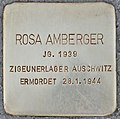
|
ROSA AMBERGER JG. 1939 AUSCHWITZ GYPSY CAMP MURDERED January 28, 1944 |
Dreipappelstrasse 1 - Fischapark |
Rosa Amberger was born in 1939 and deported to the gypsy camp Auschwitz , where she was murdered on January 28, 1944. |

|
HERE LIVED ELSA BART FIELD GEB. GEWING JG. 1900 DEPORTED 19.2.1941 KIELCE MURDERED 1942 TREBLINKA |
Wiener Strasse 10 |
Elsa Bartfeld , nee Gewing, was born on December 5, 1900 and gave birth to two children, Kurt and Lizzi Bartfeld, through her husband Salomon. She and her two children were brought to Kielce on February 19, 1941 , and murdered with her daughter in Treblinka in 1942. |

|
KURT BARTFELD JG LIVED HERE . 1935 DEPORTED 19/02/1941 KIELCE MURDERED |
Wiener Strasse 10 |
Kurt Bartfeld is the younger child of Elsa and Salomon Bartfeld. He was born on October 22, 1935 and was murdered by the Nazis either in Treblinka or Sobibor after he had been deported to Kielce with his older sister and mother in the spring of 1941. |
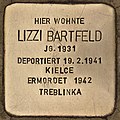
|
HERE LIVED LIZZI BART FIELD JG. 1931 DEPORTED 19.2.1941 KIELCE MURDERED 1942 TREBLINKA |
Wiener Strasse 10 |
Lizzi Bartfeld was born on February 16, 1931 in Wiener Neustadt. Shortly after her tenth birthday, she was brought to the Polish city of Kielce with her brother and mother. Like her mother, she was murdered in Treblinka in 1942. |
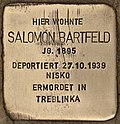
|
SALOMON BARTFELD JG LIVED HERE . 1895 DEPORTED 10/27/1939 NISKO MURDERED IN TREBLINKA |
Wiener Strasse 10 |
Salomon Bartfeld was born on June 18, 1895 in Wiener Neustadt and ran a clothes shop on Lederergasse in his hometown. From November 15, 1938 to April 6, 1939 he was in Dachau concentration camp , and four months later on to Nisko. Presumably he was able to flee from there to Vienna. Salomon Bartfeld, like his wife and daughter, was murdered in the Treblinka extermination camp . |

|
EMMA BAUER GEB. LIVED HERE. GEWING JG. DEPORTED IN 1897 1942 SOBIBOR MURDERED |
Raugasse 4 |
Emma Bauer , born on May 14, 1897 in Česká Lípa as Emma Gewing; formerly secretary and wife of Leopold Bauer. Was murdered in the Sobibor extermination camp on February 27, 1942, along with her husband and two of their children. |

|
ERNST BAUER JG LIVED HERE . DEPORTED 1923 1942 SOBIBOR MURDERED |
Raugasse 4 |
Ernst Bauer was born on September 14, 1923 in Wiener Neustadt. He was the only son of Leopold and Emma Bauer. Like his parents and his younger sister Susanne, Ernst Bauer was a victim of the Shoah , he was murdered with his family in Sobibor. |

|
DR. LEOPOLD BAUER JG LIVED HERE . DEPORTED 1879 1942 SOBIBOR MURDERED 1942 |
Raugasse 4 |
Leopold Bauer , born on May 6, 1879 in Schwarzau am Steinfeld . Leopold Bauer was a lawyer near the main square in Wiener Neustadt and married his wife Emma in 1920. On October 4, 1938, he was appointed head of the Jewish community in Wiener Neustadt. Bauer's office, in which his wife was also employed as a secretary, was confiscated and Aryanized in March 1938, and Bauer was banned from practicing the profession. In the same year the family was deported to Vienna, from where they were deported to the Sobibor extermination camp on February 27, 1942, where they were murdered. |
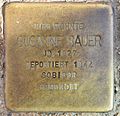
|
SUSANNE BAUER JG LIVED HERE . DEPORTED 1927 1942 SOBIBOR MURDERED |
Raugasse 4 |
Susanne Bauer , born on July 14, 1927 in Wiener Neustadt, was the youngest child of the Bauer family. Like her parents and brother, she was murdered in the Sobibor extermination camp on February 27, 1942. |

|
HERE LIVED ARNOLD LEG HACKER JG. 1892 DEPORTED 15/02/1941 OPOLE MURDERED |
Neunkirchner Strasse 35 |
Arnold Beinhacker was born on October 15, 1892 in Lackenbach . He came from a large family of wood and coal traders and married Margarethe Leitner, she was born in the same village as he was. On March 11, 1938, his trading operations were faced with an unmanageable decline in business. In April, like many other Jewish businesses, his business was closed and in December of the same year it was taken over by a German trader. Arnold Beinhacker was arrested and sent to Nisko on October 20, 1939, but was soon able to escape from there. However, this rescue was only temporary: like his wife and son Eugen, he was deported to Opole on February 15, 1941 and murdered in a nearby concentration camp, probably in Belzec or Sobibor. |
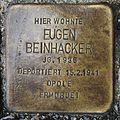
|
HERE LIVED EUGENE LEG HACKER JG. 1936 DEPORTED 15/02/1941 OPOLE MURDERED |
Neunkirchner Strasse 35 |
Eugen Beinhacker was the son of Arnold and Margarethe Beinhacker, born on June 2, 1936 in Wiener Neustadt. Like his parents, he was transported to Opole and murdered in a concentration camp adjacent there when he was only five years old. |

|
MARGARETHE BEINHACKER GEB. LIVED HERE LEITNER JG. 1903 DEPORTED 15/02/1941 OPOLE MURDERED |
Neunkirchner Strasse 35 |
Margarethe Beinhacker , nee Leitner, was born on October 17, 1903 in Lackenbach, she married the businessman Arnold Beinhacker and gave birth to their only son, Eugen, in 1936. In February 1942, she and her family were deported to Poland , where they were murdered by the Nazi regime. |

|
JOHANN BRAUN JG LIVED HERE . 1902 DEPORTED 1938 DACHAU DEPORTED 1939 NISKO DEAD 22.3.1940 |
Wiener Strasse 58 |
Johann Braun was born on August 16, 1902. He was a trained locksmith. Together with his younger sister and his parents, he moved to Wiener Neustadt in 1914, from there Braun announced himself on August 8, 1939, until then he lived in the city with his wife Maria Schmiedl, whom he married in 1907, and his wife, who was born in 1935 Son Joseph, who was baptized a Roman Catholic , although his parents were both of Jewish origin. After all, little is known about the exact circumstances of Johann Braun's death: What is certain is that he was deported to Nisko in October 1939 , where Adolf Eichmann wanted to build a huge concentration camp for all Jews in the German Reich and the areas occupied by it. Johann Braun died on March 22, 1940. |

|
GUSTAV ROBERT BRAUNBERG JG LIVED HERE . DEPORTED 1896 1944 THERESIENSTADT MURDERED AUSCHWITZ IN 1944 |
Hauptplatz 13 |
Gustav Robert Braunberg was born on January 17th, 1896 in Vienna. The dentist and dental technician Gustav Robert Braunberg later found his home in Wr. Neustadt, he ran a dental practice on the main square there until he was expelled at the end of June 1938 . Although he was baptized as a Roman Catholic and his wife Olga was considered " Aryan ", he was repeatedly the victim of anti-Semitic hostility and exposed in public as a Jew, which is why his practice was avoided from then on. Strangers pasted over his company sign with the inscription "Jewish business". SS men broke into his apartment and confiscated all valuables; he was given eight days to leave. He had to divorce his wife and say goodbye to his daughter Anni, then at least for the time being he managed to escape to Prague , where he could work for a colleague in the practice. Applications for a visa in South America were repeatedly refused, these refusals turned into a death sentence: in 1944 he was arrested, deported to Theresienstadt and on to Auschwitz, where his life ended cruelly. |

|
DAVID BREUER JG LIVED HERE . 1891 TOPOLCANY 1942 MURDERED |
Grazer Strasse 87 (corner of Ungargasse 6) |
David Breuer was born in Mattersburg on New Year's Eve 1891. He was drafted into the First World War in March 1915. In January 1917 he was sent back home as a war invalid , where he fell in love with the daughter of his landlord, Franziska Ehrenfeld. They married on February 15, 1925, and their son Heinz was born in May 1927. Breuer worked as a businessman. The marriage broke in June 1929. In 1942 the Breuer family was deported to the Topolcany district. On July 7, 1943, both were brought to Sered and killed. The fate of the son Heinz is unknown until further notice. |
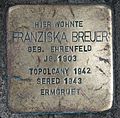
|
FRANZISKA BREUER GEB. LIVED HERE EHRENFELD JG. 1903 TOPOLCANY 1942 SERED 1943 MURDERED |
Grazer Strasse 87 (corner of Ungargasse 6) |
Franziska Breuer was the daughter of the house owner Ehrenfeld in Wiener Neustadt and was born on February 3, 1903 in Salov . She married David Breuer in 1925 and ran a sugar confectionery and chocolate factory on Ungargasse in Wiener Neustadt. The marriage broke up in the summer of 1929. Her husband moved to Berndorf . The son Heinz meanwhile attended an elementary school in Wiener Neustadt and the first grade of a federal high school , which he was allowed to finish with an official annual report card. Your company was Aryanized on May 14, 1938 after a commission. Like her husband, she was deported to Sered on July 7, 1943 and killed. |

|
HERE LIVED FRIEDRICH BUXBAUM JG. DEPORTED 1932 1941 ŁODZ MURDERED 1942 CHELMNO |
Gröhrmühlgasse 31 |
Friedrich Buxbaum |

|
JULIE BUXBAUM JG LIVED HERE . DEPORTED 1929 1941 ŁODZ MURDERED 1942 CHELMNO |
Gröhrmühlgasse 31 |
Julie Buxbaum , born on December 21, 1929. Her parents were Margarete and Julius Buxbaum. Her father worked as a cellar master and later as a sales representative. From 1938 Julie and her brother Max were banned from attending school. In 1941 the entire family was deported to the Litzmannstadt ghetto (Łódź). Her father was murdered here in 1941, Julie, her mother and her brother Max were murdered in the Chelmno extermination camp in 1942 . |

|
JULIUS BUXBAUM JG LIVED HERE . DEPORTED 1894 1941 ŁODZ MURDERED 1942 |
Gröhrmühlgasse 31 |
Julius Buxbaum was born on April 20, 1894 in Mattersburg . In the 1920s , the family man Julius Buxbaum worked in Wiener Neustadt as a cellar assistant or cellar master . Later he worked as a sales representative, the income remained low, Julius Buxbaum could only support his family simply. Because they were of the Mosaic faith, the children Max and Julie were no longer allowed to attend their schools from 1938. The now unemployed Julius Buxbaum was unable to successfully finance an escape from the Nazi regime, so the entire family had to be transported to the Litzmannstadt ghetto (Łódź) in 1941 , where Julius Buxbaum died in the Jewish ghetto in 1942. The rest of the family were murdered in the Chelmno extermination camp . |

|
HERE LIVED MARGARET BUXBAUM GEB. BOHENSZKY JG. 1,895 deported in 1941 Lodz MURDERED 1942 CHELMNO |
Gröhrmühlgasse 31 |
Margarete Buxbaum , née Bohenszky, was born on February 18, 1895 in Deutschkreutz . She was married to Julius Buxbaum, who worked as a cellar master and later as a sales representative. The couple had two children - Julie (born 1929) and Max (born 1927). In 1941 the entire family was deported to the Litzmannstadt ghetto (Łódź). Her husband was murdered here in 1941, Margarete and her children were murdered in the Chelmno extermination camp in 1942 . |

|
HERE LIVED MAX BUXBAUM JG. DEPORTED 1927 1941 ŁODZ MURDERED 1942 CHELMNO |
Gröhrmühlgasse 31 |
Max Buxbaum was born on December 22, 1927 in Wiener Neustadt. His parents were Margarete and Julius Buxbaum. His father worked as a cellar master and later as a sales representative. From 1938 on Max and his sister Julie were banned from going to school. In 1941 the entire family was deported to the Litzmannstadt ghetto (Łódź). His father was murdered here in 1941, Max, his mother and sister Julie were murdered in the Chelmno extermination camp in 1942 . |

|
JULIUS DUHL JG LIVED HERE . 1885 DEPORTED 31.8.1942 MINSK MURDERED |
Wiener Strasse 13 |
Julius Duhl was born on July 26, 1885 in Monasteryska (Poland). His father owned two brick factories, so he himself enjoyed a good education. At the age of 14, Julius came to Vienna to begin an apprenticeship as a printer, later he worked for a newspaper. During the First World War he was stationed in the munitions department in Wiener Neustadt, as a non-commissioned officer he fought in the Austrian army and was honored with at least two awards. When he married Irma Gewing in 1918, her parents gave the couple an apartment on Wiener Strasse in Wiener Neustadt, and the apartment also included a shoe shop. The couple had two children: William (born 1918) and Trudy (born 1921). In 1921, three months after Trudy's birth, Irma died of angina . A few years after Irma's death, Julius Duhl's in-laws, who had financial problems themselves, wanted the wedding present back. Julius and his children were thus homeless. Julius moved with his family to Vienna, where he pursued various activities. In 1932 Julius married the homeless Polish woman Fanny Rosenkranz. After the annexation of Austria, Julius tried to get a visa for himself and his daughter. Trudy finally got a visa and was able to leave for the USA in December 1938, where she lived with an uncle. In July 1938 Julius Duhl had to go to a forced labor camp in Hölingen near Bremen. This was dissolved in 1941, Julius Duhl was able to return to Vienna. his last residential address was Taborstrasse 61/32, a collective apartment in the second district of Vienna. On August 31, 1942, he and his wife Fanny were deported from Vienna to the Maly Trostinez extermination camp on Transport 39, Zug Da 225 (his transport number was 58) . From Wolkowysk the transport took place in freight wagons. Julius Duhl and his wife were either shot in a mass shooting or suffocated in a gas truck on September 4, 1942, the day they arrived in Maly Trostinez.
Willy Duhl married Susie Leisner in 1938, both of whom were able to flee to Palestine by illegal ship transport organized by the author William R. Perl . After the end of the war, the couple emigrated to the USA. Trudy also married and had three children. |

|
ERIKA FELDMANN JG LIVED HERE . 1932 DEPORTED 11/23/1941 KAUNAS MURDERED 11/29/1941 |
Eyerspergring 7 |
Erika Feldmann was born on April 4, 1932 in Wiener Neustadt. Her parents were Eugenie and Benno Feldmann. Her oldest brother Jakob tried to flee to Palestine with his father at the beginning of 1939, the ship crashed and the father died in the process, the brother was able to save himself. The rest of the family had to leave Wiener Neustadt and lived in a collective flat for Jews at Zirkusgasse 50 in Vienna's 2nd district. On November 23, 1941, Erika was deported from Vienna to Kaunas with her mother and her siblings Stella and Walter on Transport 11, Train Da 29. On November 29, 1941 she was at the IX. Gone, like all other 999 people on this transport, shot. |
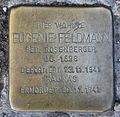
|
EUGENIE FELDMANN GEB. LIVED HERE ROSENBERGER JG. 1898 DEPORTED 11/23/1941 KAUNAS MURDERED 11/29/1941 |
Eyerspergring 7 |
Eugenie Feldmann , née Rosenberger (June 1898 in Mattersburg). The civil servant Benno Feldmann married Eugenie Rosenberger in 1920, they gave birth to a total of four children (Jakob, Stella, Walter and Erika). In 1938 Benno Feldmann took over the secretariat of the IKG in Wiener Neustadt after several members had to flee from the National Socialists. The eldest son Jakob (born 1923) tried to flee to Palestine with his father at the beginning of 1939. His father died in a shipwreck off the coast of Palestine and he was able to save himself on land. The rest of the family - presumably not informed about the death or whereabouts of father and son - were to be transported by train to Riga on November 23, 1941 with more than a thousand other Jews , but the train was diverted to Kaunas , where On November 29, 1941, the SS shot and killed all passengers. |
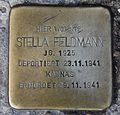
|
STELLA FELDMANN JG LIVED HERE . 1925 DEPORTED 11/23/1941 KAUNAS MURDERED 11/29/1941 |
Eyerspergring 7 |
Stella Feldmann , born in 1925. Daughter of Benno and Eugenie Feldmann. Her eldest brother Jakob tried to flee to Palestine with his father at the beginning of 1939, the ship crashed and the father died, her brother was able to save himself. The rest of the family had to leave Wiener Neustadt and lived in a collective flat for Jews at Zirkusgasse 50 in Vienna's 2nd district. On November 23, 1941, Stella was deported from Vienna to Kaunas with her mother and her siblings Erika and Walter on Transport 11, Train Da 29. On November 29, 1941 she was at the IX. Gone, like all other 999 people on this transport, shot. |

|
WALTER FELDMANN JG LIVED HERE . 1928 DEPORTED 11/23/1941 KAUNAS MURDERED 11/29/1941 |
Eyerspergring 7 |
Walter Feldmann , born in 1928. Son of Benno and Eugenie Feldmann. His eldest brother Jakob tried to flee to Palestine with his father at the beginning of 1939, the ship crashed and the father died, the brother was able to save himself. The rest of the family had to leave Wiener Neustadt and lived in a collective flat for Jews at Zirkusgasse 50 in Vienna's 2nd district. On November 23, 1941 Walter and his mother and siblings Erika and Stella were deported from Vienna to Kaunas on Transport 11, Train Da 29. On November 29, 1941 he was at the IX. Gone, like all other 999 people on this transport, shot. |

|
JOHANN FINK JG LIVED HERE . 1897 ARRESTED 1939 DACHAU MURDERED |
Nittnergasse 4 |
Johann Fink was born on October 12, 1897 in Wolfsberg near Leibnitz. He was a machine shaper, took an active part in the Wiener Neustadt labor movement and publicly professed communism. In 1937 he went to Paris, he wanted to join the International Brigades to fight against the Franco putschists. He was rejected because of his stiff wrist. Back in Austria, he was arrested, but was released for lack of evidence. In November 1939 he was arrested again, according to the Gestapo report of November 4, 1939, "because of public commitment to communism" . Johann Fink was deported to Dachau, where he was murdered that same year.
His is also commemorated on a memorial for the victims of fascism at Wiener Straße 108, also in Wiener Neustadt. |

|
KAROLINE FORMANN JG LIVED HERE . 1929 ADMINISTRATED SANCTUARY GUGGING 1941 ARNSDORF 'RUNNED' 23.6.1941 LEIPZIG-DÖSEN CHILDREN 'S DEPARTMENT MURDERED 23.8.1941 |
Airfield belt 15 |
Karoline Formann was born on October 14, 1929 in Wiener Neustadt (according to Häupl, on September 28, 1925 in Vienna). She was disabled from birth. Her parents applied to the Gugging Sanatorium to accept their child, which was approved. On March 15, 1941 she (like Rudolf Müller) was transported away by Gugging. The original destination of their trip was Hartheim Castle , but because a propaganda film for euthanasia was to be made in the German killing center in Pirna-Sonnenstein , but there were no more children there, the transport was quickly rerouted to Arnsdorf . After the filming was finished, the children were no longer needed. On June 23, 1941, Formann was transferred to the children's department in Leipzig-Dosen and killed there with medication on August 23 of the same year. |

|
ADOLF GERSTL JG LIVED HERE . 1864 DEPORTED 08/20/1942 THERESIENSTADT MURDERED 11/30/1943 |
Kollonitschgasse 5 |
Adolf Gerstl was born on July 24, 1864 in Neunkirchen. He made his living as a timber merchant. He was married to Helene Gerstl, née Kohn. The couple had five children: Ernst (born 1901), Alfred (born 1903), Fritz (born 1904), Herta (born 1908) and Paul (born 1915). Adolf Gerstl came to Wiener Neustadt in 1912 and the family moved into an apartment at Kollonitschgasse 5. The Gerstl family had a timber shop in Wiener Neustadt, which the Handelsbund called “the best shop in Wr. Neustadt ”was classified. The timber wholesaler was located on Gymelsdorferstrasse, and there were also several storage facilities with a large amount of timber. In 1938, the linearization of stocks and real estate. The Gymelsdorfergasse / Richtergasse lumber yard was purchased by the municipality (the Jewish camp for Hungarian Jews was built on the site in 1944/45). On September 7, 1938, Adolf Gerstl also had to leave his apartment and he moved to Marktgasse with his wife and sons Ernst and Paul, where they were also expelled and they came to a collective apartment for Jews at Hollandstrasse 14 in Vienna's 2nd district . Adolf Gerstl and his son Ernst were finally arrested (also in 1938) and taken to the Dachau concentration camp for a few months . The final deportation took place on August 20, 1942, Adolf and his wife were brought to Theresienstadt on Transport 37, Zug Da 504 (his number on the transport was 701). Adolf Gerstl was murdered there on December 1, 1943. His wife Helene was murdered on November 9, 1942.
All five children were able to escape. Paul and Herta can first get to Paris and then to the USA by applying to leave the country. Alfred Gerstl was also able to flee in 1938 and went to Australia. Ernst and Fritz also reached Palestine and Great Britain. |

|
HEINRICH GERSTL JG LIVED HERE . 1880 ESCAPE 1940 DEAD CAMP ATLIT TYPHUS |
Martinsgasse 8 |
Heinrich Gerstl was born on July 24, 1880 in Neufeld an der Leitha as the son of Jacob and Marie Gerstl, with whom he sometimes worked in the haberdashery after graduating from a Viennese commercial school . During the First World War , Gerstl was forced to work in an ammunition factory in Wöllersdorf , after which he opened a cutlery shop in Wiener Neustadt, where in 1933 he bought a house for his wife and four daughters. After several anti-Semitic attacks on the family, a four-week arrest of the merchant, and a forced aryanization of the family property, the family of six fled to Palestine on September 4, 1940 . The entire family did arrive there, but Heinrich Gerstl fell ill with typhus on the difficult journey . Gerstl died of the consequences of this infectious disease around three months after the flight began on December 10, 1940. |

|
HELENE GERSTL GEB. LIVED HERE KOHN JG. 1874 DEPORTED 20.8.1942 THERESIENSTADT MURDERED 9.11.1942 |
Kollonitschgasse 5 |
Helene Gerstl , née Kohn, was born on August 3, 1874 in Wiener Neustadt. She was married to the timber merchant Adolf Gerstl. The couple had five children: Ernst (born 1901), Alfred (born 1903), Fritz (born 1904), Herta (born 1908) and Paul (born 1915). Helene moved to Wiener Neustadt with her family in 1912. They moved into an apartment at Kollonitschgasse 5. The Gerstl family had a timber shop in Wiener Neustadt, which the Handelsbund called “the best shop in Wr. Neustadt ”was classified. The timber wholesaler was located on Gymelsdorferstrasse, and there were also several storage facilities with a large amount of timber. In 1938, the linearization of stocks and real estate. The Gymelsdorfergasse / Richtergasse lumber yard was purchased by the municipality (the Jewish camp for Hungarian Jews was built on the site in 1944/45). On September 7, 1938, Helene Gerstl also had to leave her apartment and she moved to Marktgasse with her husband and sons Ernst and Paul, where they were also expelled and they came to a collective apartment for Jews at Hollandstrasse 14 in Vienna's 2nd district . Her husband Adolf Gerstl and son Ernst were finally arrested in 1938 and taken to Dachau concentration camp for a few months . The final deportation took place on August 20, 1942, Helene and her husband were taken to Theresienstadt on Transport 37, Zug Da 504 (her number on the transport was 702). Helene Gerstl was murdered there on November 9, 1942. Adolf Gerstl was murdered a year later on December 1, 1943, also in Theresienstadt.
All five children were able to escape. Paul and Herta can first get to Paris and then to the USA by applying to leave the country. Alfred Gerstl was also able to flee in 1938 and went to Australia. Ernst and Fritz also reached Palestine and Great Britain. |

|
HERE LIVED ERICH GRÜNWALD JG. 1921 ESCAPE FRANCE INTERNS DRANCY DEPORTED 1942 AUSCHWITZ MURDERED |
Singergasse 15 |
Erich Grünwald was the son of Otto and Olga Grünwald, born on December 19, 1921 in Wiener Neustadt. He attended elementary and high school in his hometown , but he left the latter prematurely at the age of only 15. Like his parents, he was arrested in France after fleeing in the meantime. He was taken to the Drancy assembly camp and from there on September 16, 1942, was deported to Auschwitz on Transport 33. Erich Grünwald and his parents did not survive the Shoah . |

|
OLGA GRÜNWALD GEB. LIVED HERE. SEINFELD JG. 1901 ESCAPE FRANCE INTERNED DRANCY DEPORTED 1942 AUSCHWITZ MURDERED |
Singergasse 15 |
Olga Grünwald , née Seinfeld, was born on February 26, 1901 in Wiener Neustadt. In 1920 she married her husband Otto, with whom she had a son - Erich. Together with her husband she ran a soap factory and a seed shop . Besides Franziska Breuer, she was the only manufacturer in town. After the November pogroms, her family was expelled from the city and fled via Vienna to France, where she and her husband, son Erich and she were reassured after a few years. She was deported to Auschwitz on September 16, 1942 with Transport 33 via the Drancy assembly camp. Olga Grünwald, her son and her husband were murdered there.
Her father Max Seinfeld died in 1936. Her sister Josefine was murdered in Hartheim in March 1941. Mother Amalie had to leave the apartment on Domplatz in the course of the November pogroms and moved away from Wiener Neustadt. Brother Siegfried was last enrolled at the Medical Faculty in the 5th semester. After 1938 it was not possible to continue studying, the whereabouts of the university remain unclear. |
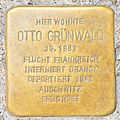
|
OTTO GRÜNWALD JG LIVED HERE . 1883 ESCAPE FRANCE INTERNED DRANCY DEPORTED 1942 AUSCHWITZ MURDERED |
Singergasse 15 |
Otto Grünwald was born on May 1, 1883 in Wiener Neustadt and worked as an authorized signatory in his father's internationally successful Kleng Institute . With his wife Olga, whom he married in April 1920 (their son Erich was born in 1921), he also ran a soap factory in the city. Trade relations were maintained across the globe, as far as Argentina and Australia . In 1938 the company had to be closed, as usual he received no financial compensation for the "sale" of the company. He and his family managed to flee to France, but only to an area of the country that was soon taken over by Hitler's Germany. On September 16, 1942, he was deported to Auschwitz on Transport 33 from the Drancy assembly camp. Otto Grünwald, his wife and son Erich were all murdered there. |

|
MAIER HACKER JG LIVED HERE . 1898 DEPORTED DACHAU 1939 CAMP NISKO MURDERED |
Dietrichgasse 23 (corner of Kamanngasse 5) |
Maier Hacker was born on December 16, 1898 in Weppersdorf in Burgenland. He was the managing director of a cattle trading company that received animals by rail, mainly from Hungary . At first he lived in Kobersdorf , where he married his wife, Regine Tauber, who was around twelve years older than him. With his three children, Robert, Siegfried and Ernst, Maier also often visited the local synagogue in Wiener Neustadt, where they had moved to give the children better educational opportunities , but he was not strictly religious. After the Anschluss, the children lost their right to attend school, and he also lost his job due to the Aryanizations and the agitation against all Jews. He is said to have discovered a poster on the streets of Vienna promising work in Lviv to all Jews who registered . Hacker naively took this "chance" on his own. Of course, there was nothing else in Lemberg than a labor camp, from where he was deported to the camp in Nisko on October 20, 1939, where he was most likely murdered. |

|
REGINE HACKER GEB. LIVED HERE TAUBER JG. DEPORTED 1886 1942 MINSK MURDERED 1942 |
Dietrichgasse 23 (corner of Kamanngasse 5) |
Regine Hacker , born Regine Tauber on November 15, 1886 in Andau , married Maier Hacker. She lived with her husband in Kobersdorf for a long time, then moved because of the three children (Robert, Ernst and Siegfried) to Wiener Neustadt, where Regine Hacker could continue to practice her trade as a seamstress . After her husband naively and voluntarily went to a labor camp in Lemberg, she stayed with her three children in Wiener Neustadt, where they could hide in the allotment garden of a non-Jewish friend. The friend was able to prevent the Nazis from searching the small hut in the allotment garden. Two of her sons were able to survive by fleeing to Palestine. She and her son Robert were deported to the Minsk camp on May 20, 1942 , where both perished. |

|
ROBERT HACKER JG LIVED HERE . DEPORTED 1925 1942 MINSK MURDERED 1942 |
Dietrichgasse 23 (corner of Kamanngasse 5) |
Robert Hacker was born as the youngest son of Maier and Regine Hacker on March 4, 1925 in Kobersdorf. Like his brothers, he was dismissed from school after the annexation of Austria. After his father's departure, Robert Hacker and his two older brothers Siegfried and Ernst hid in a friend's allotment garden. Although the possibility opened up for him, as for his brothers, to flee to Palestine via Trieste , he refused to flee in order to be able to stay with his mother. That cost him his life: Together with her, he was taken to Minsk in May 1942 and murdered there. |

|
HERMANN HACKL JG LIVED HERE . 1897 ARMENHAUS WIENER NEUSTADT DISTRIBUTED 10/7/1941 SANCTUARY GUGGING MURDERED 7/7/1944 |
Ungargasse 20 (parking garage) |
Hermann Alfred Hackl was born on March 30, 1897 in Wiener Neustadt. He was short (146 cm tall) and also had a hump. He trained as a baker and worked in this profession for ten years until he was no longer able to practice this profession due to an illness of the hand (bone caries). He kept trying to get a job through the employment office. Nevertheless, he was denounced as work shy. In 1940 he came to the old people's home on Ungargasse. On July 10, 1941, at the instigation of the Reich Governor, he and four other inmates were transferred to the Gugging Sanatorium. The examination there showed, contrary to a previous examination by the health department in Wiener Neustadt, that he was not mentally ill, did not suffer from mental weaknesses and did not need institutionalization. The Klosterneuburg district court, however, considered detention in a closed institution permissible, and this decision was extended several times. Hermann Hackl became increasingly depressed in the nursing home, but went back to work. After all, he wanted to go back to the old people's home because he had fared better there; he would have ended up in the old people's home because he was unable to work, but not because he was mentally ill. This request was not granted and his condition in the institution deteriorated. He lost a lot of weight, became bedridden and fell ill with pneumonia in early 1944, from which he officially "died" on January 7, 1944. Hermann Alfred Hackl had become a victim of Emil Gelny , who reported in a letter to the Gauhauptmann: “After all, my work has resulted in the elimination of more than 400 incurable sick people, who are seriously stressful for the state in the current situation, in the last 4 months, and the gentlemen had the greatest interest in not being crippled in my work. " |
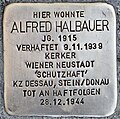
|
ALFRED HALBAUER JG LIVED HERE . 1915 ARRIVED 11/9/1939 KERKER WIENER NEUSTADT 'SCHUTZHAFT' KZ DESSAU, STEIN / DONAU DEAD OF ADHESION December 28, 1944 |
Matthias Schönerer-Gasse 10 |
Alfred Halbauer was born on January 11, 1915 in Wiener Neustadt. On November 9, 1939, shortly after an unsuccessful assassination attempt on Hitler , Alfred Halbauer met with friends to celebrate his farewell, he was supposed to join the Wehrmacht the next day. On the way home and under the influence of alcohol, he shouted “It's a shame that you didn't kill Hitler. But I'll go out and kill him myself! ”This was heard by the Hitler Youth, Franz Hauser, who immediately notified the police. Halbauer was immediately arrested and beaten bloodily. When he was handed over to the court authorities, it was noted that he was to be handed over to the Gestapo field office in Wiener Neustadt after serving his sentence. So he was supposed to go to a concentration camp afterwards . On December 8, 1939, he was sentenced to three months in hard prison. Halbauer was sent to the Stein prison , then to a concentration camp in Dessau, where he was assigned to a work detachment. Then he was taken to a bog camp , already seriously ill . He was advised to flee from the moor camp because he would not survive it. The escape failed and he was beaten and kicked. He was then chained for weeks. He survived the ordeal, but since he was now unable to work, he was sent back to Stein. Relatives were able to visit him there and obtain his release with the help of a lawyer. A medical examination showed that the stomach was inoperable. On December 28, 1944, Alfred Halbauer died at home as a result of the consequences of his imprisonment.
Hitler youth Franz Hauser had to answer before the Vienna People's Court in 1946. For the crime of denunciation, he was sentenced to one year of heavy imprisonment, had to pay the cost of the criminal proceedings, and all of his property was forfeited. |
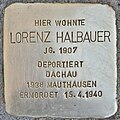
|
LORENZ HALBAUER JG LIVED HERE . 1907 DEPORTED DACHAU 1938 MAUTHAUSEN MURDERED April 15, 1940 |
Matthias Schönerer-Gasse 10 |
Lorenz Halbauer was born on July 29, 1907 in Sigleß . he was interested in politics and spoke about the political situation and what could be done about it. He was denounced because of this and when political statements were said to have come up again at a tavern riot, he was summoned to the police in Wiener Neustadt. His partner Barbara Gerdenitz received the information that it would take longer and never saw him again. He was deported to the Dachau concentration camp and on August 8, 1938, transferred with the first transport to the Mauthausen concentration camp , a transport of "professional criminals". With these 300 prisoners, Mauthausen was put into operation. Lorenz Halbauer was murdered here on April 25, 1940. According to a surviving inmate, he was killed. |

|
GERTRUDE HIRSCH JG LIVED HERE . 1921 DEPORTED MAUTHAUSEN MURDERED |
Haggenmüllergasse 25 |
Gertrude Hirsch was born on May 1, 1921 in Wiener Neustadt. She was the daughter of Sigmund and Johanna Hirsch. Sigmund's father was a leather and ribbon dealer with a shop at Neunkirchnerstrasse 6 in Wiener Neustadt. In 1930 the family moved to Haggenmüllergasse 25. During the Reichspogromnacht the family was robbed and they had to leave their apartment. The father's business and the apartment were aryanized . All three lived at different addresses in Vienna. Gertrude Hirsch lived at Ramperstorffergasse 34 in the 5th district of Vienna. She was deported and murdered in Mauthausen concentration camp . |

|
JOHANNA HIRSCH GEB. LIVED HERE LÖBL JG. 1901 DEPORTED MAUTHAUSEN MURDERED |
Haggenmüllergasse 25 |
Johanna Hirsch , née Löbl, was born on August 1, 1901 in Wiener Neustadt. She was married to the leather dealer Sigmund Hirsch. The couple had a daughter - Gertrude, born in 1925. Johanna's husband, who was a committee member of the Israelitische Kultusgemeinde in Wiener Neustadt, had a shop here at Neunkirchnerstrasse 6. In 1930 the family moved to Haggenmüllergasse 25. During the Reichspogromnacht the family was robbed and they had to leave their apartment. The business and the apartment were aryanized . All three lived at different addresses in Vienna. Johanna Hirsch lived in Vienna at Börsegasse 3 in the 1st district of Vienna. She was deported and murdered in Mauthausen concentration camp . |
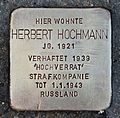
|
HERBERT HOCHMANN JG LIVED HERE . 1921 ARRESTED 1939 'HIGH TREASON' CRIMINAL COMPANY TOT 01/01/1943 RUSSIA |
Pottendorfer Strasse 121 |
Herbert Hochmann (born 1921 in Wiener Neustadt) belonged to the resistance group around Karl Flanner and is said to have recruited members, organized conspiratorial meetings and distributed anti-fascist pamphlets, including the magazine Der Jungkommunist with a print run of 40. The group was arrested and tried for high treason. The sentence for Herbert Hochmann was one year and six months in prison, but after his imprisonment he was assigned to a punishment company and was killed on January 1, 1943 in the Stalingrad area. |

|
HERE LIVED ALFRED HÖCHSTÄTTER JG. IN 1903 ARRESTED IN THE RESISTANCE 1943 MUNICH-STADELHEIM EXECUTED January 25, 1944 |
Wiener Strasse 51 |
Alfred Höchstätter (born June 5, 1902 in Wiener Neustadt ) was a worker and resistance fighter against the Nazi regime . He was charged with distributing the Red Flag and other Nazi-critical writings. He was sentenced to death by the People's Court on November 19, 1943 and executed with the guillotine two months later, on January 25, 1944, in Munich-Stadelheim . |

|
JOHANN HÖDL JG LIVED HERE . ARRESTED 1888, MURDERED IN 1940, MAUTHAUSEN |
Kaisersteingasse 13 |
Johann Hödl was born on October 11, 1888 in Gloggnitz. He was married and head of Gutenstein's station and for a long time was a driver in Wiener Neustadt. In the 1930s he became city director of the Wiener Neustadt home guard. After the July coup was suppressed on July 25, 1934, he took part in the supervision of imprisoned Nazis. On the night of March 11th to March 12th, 1938, i.e. one night before the annexation of Austria , he was picked up by Nazis led by an illegal SA man. Hödl was taken to the police prison in Wiener Neustadt, where his wife could visit him the next day. Then Hödl was brought to Vienna and then deported to the Dachau concentration camp on the first transport of Austrian prisoners . A short time later he was transferred to the newly built Mauthausen concentration camp . His health deteriorated and he wrote to his wife from the hospital: "If something should happen to Hans during the war, get a family grave in Wampersdorf and have him transferred there." Since there was no Hans in the family and Johann Hödl liked to stay in Wampersdorf himself, this message probably served to understand what should happen to him after his death. His wife finally received news that he had died of a stroke on March 27, 1940. |
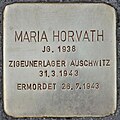
|
MARIA HORVATH JG. 1938 AUSCHWITZ GYPSY CAMP 31.3.1943 MURDERED 26.7.1943 |
Dreipappelstrasse 1 - Fischapark |
Maria Horvath was born in 1938 and deported to the gypsy camp Auschwitz on March 31, 1943 , where she was murdered on July 26, 1943. |

|
LUDWIG HUBER JG LIVED HERE . 1894 ARRESTED IN THE RESISTANCE 1941 'HIGHLY TREASON'
|
Hauptplatz 20 |
Ludwig Huber was born on July 24, 1894 in Tauch am Wechsel and worked as a factory worker for a long time. From 1920 to 1934 he was a freelance rail union member of the SDAP , after which Huber changed political sides and from then on acted as a member of the Austro-fascist " Fatherland Front ". At the beginning of 1940 Huber changed the area again and became part of a communist group based in Kottingbrunn , which had close ties to the KPÖ , which operated underground . The group distributed leaflets and calls for overthrow. The organization was dug up in 1940, 15 members arrested and sent to a Viennese pre-trial detention center. Ludwig Huber has been to three years prison sentenced. In July 1943 he was released from custody and drafted to the Yugoslavia Front, where he probably died in fighting from October 16 to 17, 1944. In the waiting hall of Wiener Neustädter Bahnhof there has been a memorial plaque for him and two other former railway workers since 1999. |

|
KATHARINE KAROLY JG. 1934 AUSCHWITZ GYPSY CAMP 31.3.1943 MURDERED 4.2.1944 |
Dreipappelstrasse 1 - Fischapark |
Katharine Karoly was born in 1934 and deported to the gypsy camp Auschwitz on March 31, 1943 , where she was murdered on February 4, 1944. |

|
FRANZ KASTEINER JG LIVED HERE . 1905 1937 SPANISH CIVIL WAR EXTRIBUTION GESTAPO EXECUTED 1942 GROSS-ROSEN |
Airfield belt 13/15 |
Franz Kasteiner , who was born in Dunkelstein on January 17, 1905 , embarked on the Spanish Civil War in 1937 , where he fought on the side of the Republicans. As early as 1934 he fought as a " Schutzbündler " for a democratic movement and was imprisoned for a long time because of this mission. Arrested in Spain by Franco troops , he was handed over to the SS and deported by them to Groß-Rosen ( Silesia ), where he had to burn the corpses of his fellow inmates in the crematorium department. Probably Kasteiner was shot, at least SS-Gruppenführer Richard Glücks usually gave orders to execute the workers in that department every three weeks. In the message to Kasteiner's brother Karl on November 24, 1942 it is written: “(...) Dear Mr. Kasteiner! Her brother Franz Kasteiner called in sick a few days ago and was then admitted to the infirmary for medical treatment. He was given the best possible drug and nursing treatment. In spite of all the medical efforts used, the disease could not be mastered. I extend my condolences to you on this loss. Your brother did not utter any final wishes before his death. I have directed the prisoner property management of my camp to mail your brother's estate to your address. The camp commandant (...) " |
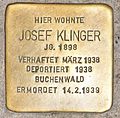
|
JOSEF KLINGER JG LIVED HERE . 1898 ARRESTED MARCH 1938 DEPORTED 1938 BUCHENWALD MURDERED 02/14/1939 |
Bahngasse 44 |
Josef Klinger was born on November 8, 1898 in Gloggnitz and worked as a typesetter . On March 17, 1938, a few days after the Anschluss in Austria , Josef Klinger was arrested by the Nazis and taken to Wöllersdorf . A reason for the arrest was not given. That was because the detention was an act of revenge. When the National Socialists in Austria were still illegally distributing their writings underground, Klinger refused to print their propaganda writings. As a reaction to this, the Nazis took him to Buchenwald concentration camp as soon as they could (April 1938), where the athletic man soon became emaciated and ill due to poor nutrition and hard work. He was able to keep himself alive until February 14 of the following year. |

|
FELIX KOBLER JG LIVED HERE . CONVINCED IN 1889, 1942 HEARING FROM 'ENEMY' STREHLITZ MURDERED AUSCHWITZ |
Steinfeldgasse 18 (corner of Siglgasse 9a) |
Felix Kobler was born in Prague on January 27, 1889. He was a trained saddler. In 1921 he married the master baker's daughter Rosa Reismüller. The couple had a daughter - Gertrude (born 1929). In 1934 he learned the bakery trade from his father-in-law and took over the bakery in 1937. After the annexation of Austria , he was no longer allowed to continue and he moved to Vienna without his family and worked as a baker's assistant until July 1939. Then he was sent to various labor camps, including on the Präbichl. From April 1941 he was back in Vienna and worked in the 16th district of Vienna. In August 1941 he met Johann Schaffranek, who owned a Siemens radio. Both listened to the German-language news on the London broadcaster. On June 26, 1942, they were sentenced by a special court at the Vienna Regional Court: Felix Kobler to three years in prison, Johann Schaffranek to two years in prison. Felix Kobler was sent to the Groß-Strehlitz forced labor camp. Felix Kobler was pronounced dead in 1949. |
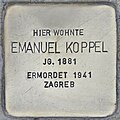
|
EMANUEL KOPPEL JG LIVED HERE . 1881 MURDERED IN 1941 ZAGREB |
Wiener Strasse 90 |
Emanuel Koppel was born in Wiesen in 1881. He was married to Therese, née Gross, and earned his living as a trader. The couple had three children - Alfred (born 1908), Edith (born 1912) and Helene (born 1924). Son Alfred was mentally handicapped and came to the Mauer-Öhling sanatorium in 1932 , where, according to official information, he “died of pulmonary tuberculosis”. On February 15, 1939, it was noted that Emanuel and his wife had emigrated to Yugoslavia. The couple fled to Brčko and Zagreb. In 1941 Emanuel Koppel and his wife Therese were murdered in Zagreb.
Both daughters were able to flee in time, Helene got to Australia and Edith to Palestine. |
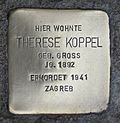
|
HERE LIVED THERESE KOPPEL GEB. LARGE JG. 1892 MURDERED 1941 ZAGREB |
Wiener Strasse 90 |
Therese Koppel , née Gross, was born on January 15, 1892 in Győr. She was married to Emanuel Koppel, a dealer. The couple had three children - Alfred (born 1908), Edith (born 1912) and Helene (born 1924). Son Alfred was mentally handicapped and came to the Mauer-Öhling sanatorium in 1932, where, according to official information, he “died of pulmonary tuberculosis”. On February 15, 1939, it was noted that Therese and her husband had emigrated to Yugoslavia. The couple fled to Brčko and Zagreb. In 1941 Therese Koppel and her husband Emanuel Koppel were murdered in Zagreb.
Both daughters were able to flee in time, Helene got to Australia and Edith to Palestine. |

|
JOHANNA KRAUS JG LIVED HERE . 1872 POOR HOUSE WIENER NEUSTADT INSTRUCTED HEILANSTALT WALL Oehling 1939 HEILANSTALT gugging 1943 MURDERED 12/12/1943 |
Ungargasse 20 (parking garage) |
Johanna Kraus was born in Winzendorf in 1872. Her short stature initially did not prevent her from working as a cleaning lady and sublet in Wiener Neustadt am Corvinusring. Due to progressive osteoporosis , she was admitted to the Sophienspital in Vienna, where she defended herself against her treatment, which ensured that she was referred to the “ Am Steinhof ” institution . There she was described as calm, intelligent and focused on the essentials, but she was transferred to Mauer-Öhling. There it was decided on October 13, 1939 that she was not in need of an institution and could therefore be released. She was admitted to an old people's home in Wiener Neustadt, where in 1943 a medical report was supposed to determine that Kraus was "idiotic" and that a stay in an institution was therefore recommended - on February 23 of the same year she was brought back to Mauer-Öhling. In the files it is described as “not usable for work” and “weak and cumbersome”. Johanna Kraus was murdered on December 12, 1943. |

|
ARNOLD LEMBERGER JG LIVED HERE . DEPORTED IN 1877 1941 MINSK MURDERED |
Herzog Leopold-Strasse 3 |
Arnold Lemberger was born on June 1, 1877 in Freistadt ( Moravia ). He was married to Bella, nee Kohn, and the couple had three children. From 1918, he ran a department store in downtown Wiener Neustadt for twenty years. Lemberger offered, among other things, textiles, leather and sports goods, the shop was very busy, so Lemberger could afford up to six employees. Lemberger was a member of the Jewish community's cultural committee. Arnold Lemberger was one of the few business people who dared to defend himself against the aryanization of his company in 1938; he refused the authorities an important signature. Of course, in the end this could not prevent the final Aryanization of his company in December 1938, he himself and his family fled to Vienna after the November pogroms, he was able to organize a trip to Great Britain for his three children, they survived. At the beginning of 1940 Lemberger was still demanding sums of money to take over his business. Arnold Lemberger - as a once highly respected and kindly greeted gentleman - found it difficult to cope with the new circumstances. He and his wife were deported to Minsk on November 28, 1941 and murdered there. |

|
BELLA LEMBERGER GEB. LIVED HERE KOHN JG. DEPORTED 1890 1941 MINSK MURDERED |
Herzog Leopold-Strasse 3 |
Bella Lemberger , née Kohn, was born on February 15, 1890 in Nikolsburg . She was married to Arnold Lemberger, a dealer. The couple had three children. One day ahead of the “Reichskristallnacht” she was arrested by SS soldiers with her three children - her husband was in Vienna - and locked in a synagogue and asked to destroy the interior. They were also humiliated through the streets of Wiener Neustadt and laughed at by passers-by. Like her husband, she was deported to Minsk on November 28, 1941 and murdered.
All three children managed to survive in exile from Great Britain. |
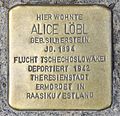
|
ALICE LÖBL GEB. LIVED HERE SILBERSTEIN JG. 1894 ESCAPE CZECHOSLOVAKIA DEPORTED 1942 THERESIENSTADT MURDERED IN RAASIKU / ESTONIA |
Wienerstraße 9 (corner of Herrengasse 2) |
Alice Löbl , née Silberstein, was born on May 1, 1894 in Teplitz-Schönau. She had been married to Gustav Löbl, a bank director of the Allgemeine Verkehrsbank , since 1921 . The couple had one son - Kurt Josef, born in 1922. The family lived in Wiener Neustadt at Wienerstraße 9 from 1936 onwards. Alice and her family fled to Czechoslovakia at the end of July or on August 1, 1938, where they lived briefly in Brno . On January 28, 1942, Alice was deported with her husband and son on Transport U (her number on the transport was 631) from Brno to Theresienstadt. On September 1, 1942, she was transferred (again with her husband and son) to Raasiku on Transport Be (her number on the transport was 228). At the station, the 1500 people had to undergo a selection. Most of them were brought by bus to the Jägala or Kalevi-Liivi area on the Baltic Sea. There they had to undress and were shot. Alice Löbl and her family were also shot here. |
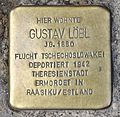
|
GUSTAV LÖBL JG LIVED HERE . 1880 ESCAPE CZECHOSLOVAKIA DEPORTED 1942 THERESIENSTADT MURDERED IN RAASIKU / ESTONIA |
Wienerstraße 9 (corner of Herrengasse 2) |
Gustav Löbl was born on March 12, 1880 in Roudnice . In 1910 Gustav Löbl came from Vienna to Wiener Neustadt to work as an authorized signatory of the Allgemeine Verkehrsbank . In 1921 he married Alice Löbl. The couple had a son - Kurt Josef, born in 1922. From 1936 the family lived in Wiener Neustadt at Wienerstraße 9. Gustav Löbl had meanwhile become bank director. Gustav and his family fled to Czechoslovakia at the end of July or August 1, 1938, where they lived briefly in Brno. On January 28, 1942, Gustav was deported with his wife and son on transport U (his number on the transport was 630) from Brno to Theresienstadt. On September 1, 1942, he was transferred (again with his wife and son) to Raasiku on Transport Be (his number on the transport was 227). At the station, the 1500 people had to undergo a selection. Most of them were brought by bus to the Jägala or Kalevi-Liivi area on the Baltic Sea. There they had to undress and were shot. Gustav Löbl and his family were also shot here. |

|
HERE LIVED KURT Löbl JG. 1922 ESCAPE CZECHOSLOVAKIA DEPORTED 1942 THERESIENSTADT MURDERED IN RAASIKU / ESTONIA |
Wienerstraße 9 (corner of Herrengasse 2) |
Kurt Josef Löbl was born on August 31, 1922 in Vienna . He was the son of Alice and Gustav Löbl. From 1932 Kurt attended the federal high school. In 1936 the family moved to Wienerstraße 9. Kurt Josef was able to finish school in 1938, then the family fled to Czechoslovakia at the end of July or on August 1, 1938, where they lived briefly in Brno. On January 28, 1942, Kurt and his parents were deported from Brno to Theresienstadt on Transport U (his number on the transport was 632). On September 1, 1942, he was transferred (again with his parents) to Raasiku on Transport Be (his number on the transport was 229). At the station, the 1500 people had to undergo a selection. Most of them were brought by bus to the Jägala or Kalevi-Liivi area on the Baltic Sea. There they had to undress and were shot. Kurt Josef Löbl and his parents were also shot here. |

|
LEOPOLD MARTINOWSKY JG. 1906 ARRESTED April 17, 1944 'SCHUTZHAFT' FLOSSENBÜRG MURDERED 3.2.1945 |
Dreipappelstrasse 1 - Fischapark |
Leopold Martinowsky was born on November 1st, 1906 in Ebreichsdorf and earned his living as a painter. During the war he supported the forced laborers of the Rax works in Wiener Neustadt, who he let in his basement even during the air raids, shared food with them and transmitted news from foreign broadcasters. On April 17, 1944, Leopold Martinowsky was arrested for "subversive statements". He was denounced by the Nazi block leader of the settlement, Karlacek, who in turn had a close relationship with Martinowsky's mother. This had broken off the relationship with her own son. The Gestapo field service in Wiener Neustadt applied for admission to a concentration camp. On September 4, 1944, he arrived as a political prisoner in the Flossenbürg concentration camp , his prisoner number was 20357. On February 3, 1945, Leopold Martinowsky was murdered here. |

|
KURT MÜLLER JG LIVED HERE . 1935 FATE UNKNOWN |
Baumkirchnerring 5 |
Kurt Müller was born on January 12, 1935 in Wiener Neustadt. His parents were Lazar and Rosa Müller. They had a shop on Herzog-Leopold-Strasse in Wiener Neustadt. After the annexation , the parents' business was Aryanized , the children were forbidden from attending school and the rental agreement for the apartment was also terminated. The family tried to flee. Kurt Müller last stayed in Nadas in Czechoslovakia, where the escape ended. On April 11, 1942, he was deported from Trnava to Lublin. Kurt Müller did not survive the Shoah . |

|
LAZAR MÜLLER JG LIVED HERE . 1897 FATE UNKNOWN |
Baumkirchnerring 5 |
Lazar Müller was born in Nadas on November 22, 1897. The master watchmaker Lazar Müller ran a shop on Herzog-Leopold-Strasse in Wiener Neustadt with his wife Rosa, née Kurzweil, a hat maker . The couple had four children - Paul (born 1927), Wolfgang (born 1929), Ruth (born 1930) and Kurt Josef (born 1935). The business was robbed from the family in March 1938 in the course of the Aryanization . The four children who were already capable of school, i.e. Paul, Wolfgang and Ruth Müller, were banned from going to school by the Hitler regime. In the autumn of the same year, the family's lease was finally canceled, and Lazar Müller and his family wanted to flee the anti-Semitic atmosphere. Among other things, the family stayed in Bratislava , then in Nadas. The escape was unsuccessful. On April 11, 1942, Lazar Müller was deported from Trnava to Lublin. Lazar Müller did not survive the Shoah . The rest of the family was also murdered, only about Rosa Müller is unknown whether she was able to survive the Holocaust . |

|
PAUL MÜLLER JG LIVED HERE . 1927 MURDERED 1942 AUSCHWITZ |
Baumkirchnerring 5 |
Paul Müller was born on April 29, 1927 in Wiener Neustadt. His parents were Rosa and Lazar Müller. They had a shop on Herzog-Leopold-Strasse in Wiener Neustadt. After the annexation , the parents' business was Aryanized , the children were forbidden from attending school and the rental agreement for the apartment was also terminated. The family tried to flee. Paul Müller last stayed in Nadas in Czechoslovakia, where the escape ended. On April 11, 1942, he was deported from Trnava to Lublin. According to the inscription on the stumbling block, Paul Müller was transferred to Auschwitz in 1942 and was murdered there. |

|
HERE LIVED RUDOLF MÜLLER JG. 1930 ADMISSIONED 1940 HEILANSTALT GUGGING 1941 ARNSDORF 'VERLEGT' 04/08/1941 LEIPZIG-DÖSEN CHILDREN 'S DEPARTMENT MURDERED 09/22/1941 |
Kesslergasse 15 |
Rudolf Müller was born on March 21, 1930 in Wiener Neustadt and was considered mentally handicapped from birth . When he was ten years old, Rudolf was transferred to the “State Care and Employment Institution for Insane Children” in Maria Gugging because of his “very limited educational ability”. On March 15, 1941, he was transferred to Arnsdorf, the original destination of his trip was Hartheim Castle , but because a propaganda film for euthanasia was to be made in the German killing center Pirna-Sonnenstein , but there were no more children there, the transport to Arnsdorf was diverted. After filming was finished, the children were no longer needed. On August 4, 1941, Rudolf Müller was transferred to the children's department in Leipzig-Dosen and killed there on September 22, 1941 with drugs. |

|
RUTH MÜLLER JG LIVED HERE . 1930 FATE UNKNOWN |
Baumkirchnerring 5 |
Ruth Müller was born on March 20, 1930 in Wiener Neustadt. Her parents were Lazar and Rosa Müller. They had a shop on Herzog-Leopold-Strasse in Wiener Neustadt. After the annexation , the parents 'business was Aryanized , the children were forbidden from attending school (Ruth had attended the "Jubilee School Girls' Elementary School") and the rental contract for the apartment was also terminated. The family tried to flee. Ruth Müller last stayed in Nadas in Czechoslovakia, where the escape ended. On April 11, 1942, she was deported from Trnava to Lublin. Ruth Müller did not survive the Shoah . |
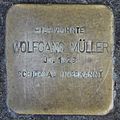
|
WOLFGANG MÜLLER JG LIVED HERE . 1929 FATE UNKNOWN |
Baumkirchnerring 5 |
Wolfgang Müller was born on March 5, 1929 in Wiener Neustadt. His parents were Lazar and Rosa Müller. They had a shop on Herzog-Leopold-Strasse in Wiener Neustadt. After the annexation , the parents' business was Aryanized , the children were forbidden from attending school and the rental agreement for the apartment was also terminated. The family tried to flee. Wolfgang Müller last stayed in Nadas in Czechoslovakia, this is where the escape ended. On April 11, 1942, he was deported from Trnava to Lublin. Wolfgang Müller did not survive the Shoah . |

|
HELGA PAUER JG LIVED HERE . 1939 'INSTRUCTED' 17.6.1941 HEALANSTALT AM STEINHOF CHILDREN 'S DEPARTMENT MURDERED 18.8.1941 |
Mießlgasse 43 |
Helga Pauer was born on July 7, 1933 in Graz. She was a home birth, with complications that led to intellectual disability. Her father Rudolf Pauer was a mechanical engineer. In 1940 he got a job at the Wiener Neustädter Flugzeugwerke (WNF), he moved from Berlin to Wiener Neustadt and also brought his family from Graz to live with him.
Helga Pauer suffered from convulsions, so she was examined by a doctor and the pediatrician reported Helga to Berlin; in the doctor's diagnosis, she was denied any development potential. On June 17, 1941, the child was fetched from the family by representatives of the Wiener Neustädter health department and taken to the Spiegelgrund “children's department” . Here she was housed in pavilion 15, the "murder pavilion". The housed children, there should be almost 800, were brought into a state of twilight by medication, from which they could no longer wake up. On August 16, 1941, Heinrich Gross reported the child's illness to the father, stating that she suffered from “severe toxic diphtheria ” and that “the child might well be expected to die”. On August 18, the family received news of their death. Helga Pauer, a victim of Operation T4 , was murdered on Spiegelgrund. |

|
HERE LIVED CHARLOTTE Pollak GEB. ADLER JG. DEPORTED 1896 1941 THERESIENSTADT MURDERED IN 1942 AUSCHWITZ |
Langegasse 5 (corner of Lederergasse 1) |
Charlotte Pollak was born as Charlotte Adler on February 28, 1896 in Eisenstadt. She was married to Friedrich Pollak and the couple had four children. Charlotte ran a hatmaker's shop in Neunkirchen, so the couple moved here for the first time, and later to Payerbach . Charlotte had a mask rental facility here. Charlotte Pollak's husband was the representative for Eternit panels for all of Austria. In 1931, by now the family was six, the Pollaks moved to Wiener Neustadt. After the annexation of Austria, the family, Friedrich Pollak was a Czech citizen, fled to Brno . On December 5, 1941, Charlotte Pollak, her husband and the children Edith and Inge were deported from here to the Theresienstadt concentration camp and on to Auschwitz-Birkenau - where Charlotte Pollak, her husband and two younger children were murdered in 1942.
The two older children Gertrude and Kurt had managed to escape into exile. First they traveled to Tulcea (Romania) and then took the ship Milos to Palestine. Both survived. |
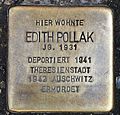
|
EDITH POLLAK JG LIVED HERE . 1931 DEPORTED 1941 THERESIENSTADT MURDERED IN 1942 AUSCHWITZ |
Langegasse 5 (corner of Lederergasse 1) |
Edith Pollak was born on December 14, 1931 in Payerbach. She was the youngest of four children from Friedrich and Charlotte Pollak. Her mother ran a mask rental company in Payerbach. Her father was a sales representative for Eternit panels and in this capacity traveled all over Austria. In 1931 the family of six moved to Wiener Neustadt. After the annexation of Austria, the Pollaks, Friedrich Pollak was a Czech citizen, fled to Brno . On December 5, 1941, Edith Pollak, together with her parents and sister Inge, was deported from here to the Theresienstadt concentration camp and on to Auschwitz-Birkenau - here Edith Pollak, her parents and her sister were murdered in 1942.
The two older siblings Gertrude and Kurt managed to escape into exile. First they traveled to Tulcea (Romania) and then took the ship Milos to Palestine. Both survived. |

|
FRIEDRICH POLLAK JG LIVED HERE . DEPORTED 1893 1941 THERESIENSTADT MURDERED IN 1942 AUSCHWITZ |
Langegasse 5 (corner of Lederergasse 1) |
Friedrich Pollak , born in Vienna on November 21, 1893, moved to the nearby town of Neunkirchen after his marriage to Charlotte Adler , where his wife ran a hat shop. Later the move to Payerbach took place . Friedrich Pollak was engaged as a representative and sold Eternit plates all over Austria with a motorcycle. The younger of the four children were born in Payerbach, and in 1931 the family of six moved to Wiener Neustadt. Because Friedrich Pollak only had a Czech passport, he escaped from the Nazis in 1938 in the direction of Brno . The family stayed there for almost three years, on December 5, 1941 they were deported to the Theresienstadt concentration camp and on to Auschwitz-Birkenau - there, apart from the two older children who had managed to escape into exile, all family members were murdered. |
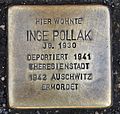
|
INGE POLLAK JG LIVED HERE . DEPORTED 1930 1941 THERESIENSTADT MURDERED AUSCHWITZ 1942 |
Langegasse 5 (corner of Lederergasse 1) |
Inge Pollak was born on March 19, 1930 in Payerbach. She was the third of four children from Friedrich and Charlotte Pollak. Her mother ran a mask rental company in Payerbach. Her father was a sales representative for Eternit panels and in this capacity traveled all over Austria. In 1931 the family of six moved to Wiener Neustadt. After the annexation of Austria, the Pollaks, Friedrich Pollak was a Czech citizen, fled to Brno . On December 5, 1941, Inge Pollak, together with her parents and sister Edith, was deported from here to the Theresienstadt concentration camp and on to Auschwitz-Birkenau - Inge Pollak, her parents and her sister were murdered here in 1942.
The two older siblings Gertrude and Kurt managed to escape into exile. First they traveled to Tulcea (Romania) and then took the ship Milos to Palestine. Both survived. |

|
EMMA POPPINGER JG LIVED HERE . 1907 SANCTUARY GUGGING MURDERED 04/04/1943 |
Wassergasse 9 |
Emma Poppinger was born on December 19, 1907 in Wiener Neustadt. She was murdered in the Gugging Sanatorium as part of Action T4 and is considered a victim of euthanasia under National Socialism due to her intellectual disability. Poppinger was impaired from birth and lived with her parents in Wr until 1939. Neustadt, whereby her father died in 1926. Two years after her admission to the district nursing home in Wiener Neustadt, which was actually much too narrow for nursing care, she was referred to the Gugging sanatorium with four other residents. She is described in reports as "calm", "harmless", "keeping herself clean" and "quickly satisfied", but because of her disability she was considered "not usable for any work", which would ultimately cost her her life. She became more and more emaciated and lost over 20 kg of body weight within a year, when Vienna-based sister Marie Kellner was appointed her guardian . At the beginning of 1943 Emma Poppinger was transferred to the infection department, from then on her sister was no longer allowed to visit her. Like 111 other patients, she died in the infection department on April 4, 1943. Testimony has meanwhile proven that the Nazi doctor Rudolf Lonauer killed a large number of patients with medication so that there would be space to use the sanatorium as a reserve hospital can. |

|
JULIUS PUSCHEK JG LIVED HERE . ARRESTED 1890 1939 BUCHENWALD MURDERED 1942 |
Pottendorfer Strasse 121 |
Julius Puschek was born on May 7, 1890 in Wiener Neustadt. He was an Austrian toolmaker, KPÖ functionary and resistance fighter against the Nazi regime. He wasmurderedin Buchenwald concentration camp on November 10, 1942 for political reasons. |

|
BERTA REININGER GEB. LIVED HERE KERPEL JG. 1867 DEPORTED 5.1.1943 THERESIENSTADT MURDERED 1944 |
Kollonitschgasse 12 |
Berta Reininger was born on April 8 or 9, 1867 in Mattersburg. She and her husband Wilhelm, who died in 1921, had seven children. In old age she lived with her son Hugo, owner of a wine shop and schnapps distillery , making her a respected personality in Wiener Neustadt. While Hugo and his wife were able to flee to Montevideo in 1939 , Berta Reininger stayed in the Wiener Neustädter apartment, on January 5, 1943 she was deported from Vienna to the Theresienstadt concentration camp, where she fell victim to the Holocaust on August 20, 1944.
Of her children and grandchildren, only Trude Bibring, who managed to escape to Palestine, most likely lives today. Her granddaughter Martha was stopped while trying to escape to Palestine in Yugoslavia and was murdered there by Germans. The remaining fates are unknown. |

|
HERE LIVED ANNA RIBITZ JG. 1894 ARMENHAUS WIENER NEUSTADT DISTRIBUTED IN MAUER-ÖHLING 1940 SANCTUARY GUGGING 1943 MURDERED 11/12/1943 |
Ungargasse 20 (parking garage) |
Anna Ribitz was born in 1894. She was admitted to the Mauer-Öhling sanatorium on February 20, 1930 , after the Wiener Neustadt health department had classified her as a self-endangering mentally ill person and deemed her admission to a closed institution necessary. She was considered calm and orderly with a depressive mood. On May 11, 1933, she was released as cured. About three weeks later, the medical officer in Wiener Neustadt again recommended a referral, as it would be insane and dangerous to the public. She came again to the Mauer-Öhling sanatorium. She was considered depressed and tearful, in 1935 she was dismissed - her condition had improved, she was talkative, willing to work and easy to use. In mid-1940, the health department saw them again as dangerous to the public and to themselves. She also diagnosed the old people's home where Anna Ribitz had lived for a while as contentious and unbearable, and she would have threatened other people in need of care. On July 29, 1940, he was admitted to the Steinhof; on July 31, he was transferred back to Mauer-Öhling. In 1943 she was finally transferred to Gugging, where Anna Ribitz was murdered on November 12, 1943. |

|
IDA RIEGLER GEB. LIVED HERE. BASCH JG. DEPORTED 1882 1942 MINSK MURDERED MALY TROSTINEC |
Baumkirchnerring 9 |
Ida Riegler , born on January 15, 1882 in Kobersdorf as Ida Basch. The Riegler family originally came from Kobersdorf in what is now Burgenland , then still western Hungary . Only in 1918 did she move to Wiener Neustadt. After the annexation of Austria, the family had to move to Vienna and they last lived in a collective flat for Jews in Sperlgasse in Vienna's 2nd district. November 1938 son Armin managed to escape to Palestine, daughter Frieda fled to London in 1939. On June 2, 1942, Ida Riegler was deported to Minsk with her husband and daughter Irma. Ida Riegler was murdered in the Maly Trostinez extermination camp . |

|
IRMA RIEGLER JG LIVED HERE . 1906 DEPORTED 1942 MINSK MURDERED MALY TROSTINEC |
Baumkirchnerring 9 |
Irma Riegler was the daughter of Nathan and Ida Riegler, born on July 2, 1906 in Kobersdorf. In 1918 she moved with her family to Wiener Neustadt. After the annexation of Austria, the family had to move to Vienna and they last lived in a collective flat for Jews in Sperlgasse in Vienna's 2nd district. On June 2, 1942, Irma Riegler and her parents were deported to Minsk. Irma was murdered in the Maly Trostinez extermination camp .
November 1938 her brother Armin managed to escape to Palestine, sister Frieda fled to London in 1939 and survived there. |

|
NATHAN RIEGLER JG LIVED HERE . DEPORTED 1878 1942 MINSK MURDERED MALY TROSTINEC |
Baumkirchnerring 9 |
Nathan Riegler was born on February 7, 1878 in Kobersdorf. He married Ida Basch and they had three children - Armin, Ida and Irma. Not until 1918 did he move to Wiener Neustadt with his family. After the annexation of Austria, the family had to move to Vienna and they last lived in a collective flat for Jews in Sperlgasse in Vienna's 2nd district. November 1938 son Armin managed to escape to Palestine, daughter Frieda fled to London in 1939. On June 2, 1942, Nathan Riegler was deported to Minsk with his wife and daughter Irma. Nathan Riegler was murdered in the Maly Trostinez extermination camp . |

|
HEINRICH SAUER JG LIVED HERE . ARRESTED 1893 1941 MURDERED 1945 STEIN AD DONAU |
Airfield belt 13/15 |
Heinrich Sauer was born on April 10, 1892 in Wernig and worked for the Südbahn from the age of 17 . He was the father of two children and married in 1919. He lived in simple circumstances on Feldgasse in Wiener Neustadt. Shortly after the end of the First World War, Sauer joined the Social Democratic Workers' Party in Austria and, as part of the “ Republican Protection Association ”, was also actively involved against Austrofascism . When the Hitler regime threatened to establish itself politically, Heinrich Sauer gathered colleagues from Wiener Neustadt who were ready to fight and consulted with them on how to counteract the danger of National Socialism. He donated his house to an illegal communist youth organization for printing the newspaper “Der Kampf”. Among the resistance, Sauer collected amounts to support the imprisoned railway worker Leopold Huber, who was sentenced to three years in prison for preparation for high treason. His group soon expanded to include larger parts of the southern line, for example to Neunkirchen , Leobersdorf and Vöslau . He and his colleagues were arrested between August and November 1941, Heinrich Sauer was sentenced to twelve years in prison, which was to cost him his life due to the increasingly tiny food rations. Sauer died on January 2, 1945 in the Stein an der Donau prison and could no longer witness the liberation of Austria he had longed for. The Feldgasse, in which he lived at the time, was renamed "Heinrich-Sauer-Gasse" in 1970 by a municipal council resolution. |
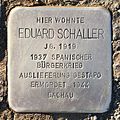
|
EDUARD SCHALLER JG LIVED HERE . 1919 1937 SPANISH CIVIL WAR EXTRACTION GESTAPO MURDERED 1944 DACHAU |
Airfield belt 13/15 |
Eduard Schaller fought alongside the democratic movement during the Spanish Civil War . He was born on January 9, 1919 in Wiener Neustadt. He volunteered for the " Red Aid " and in 1937 went to war with several other Wiener Neustadt men. After the war had been won by the Axis powers , and thereby the fascist General Franco , Schaller tried to travel to his homeland again. He was picked up at the border crossing to France and handed over to the Schutzstaffel, which deported him to the Dachau concentration camp . A good friend from his youth and later historian with a focus on World War II, Karl Flanner , was later also imprisoned there, but the friends could not see each other again because Schaller was already in the Friedrichshafen branch . In April 1944, Flanner, a block clerk, found an index card with his friend's name on which the death of his friend from an American bomb was reported. Over fifty years later, the teacher at the Musikhochschule Wiener Neustadt set Eduard Schaller's life to music in a melodrama and performed it publicly at a memorial service for the Spanish fighters. |
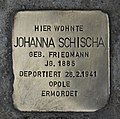
|
JOHANNA SCHISCHA GEB. LIVED HERE FRIEDMANN JG. 1885 DEPORTED 26.2.1941 OPOLE MURDERED |
Kaiserbrunngasse 17 |
Johanna Schischa , née Friedmann, was born on May 19, 1885 in Prein an der Rax . She met her future husband Wilhelm Schischa, whom she married in 1908, at a Purim ball . Wilhelm was a master tailor and he opened a men's clothing store at Domplatz 3 in Wiener Neustadt. In 1914 they became parents of a son - Eduard, and in 1927 their daughter Karoline followed. The family lived in a house with a garden at Kaiserbrunngasse 17 in Wiener Neustadt. Eduard also trained as a tailor and helped in his father's business. After the annexation of Austria in 1938, the family lost the business and it was Aryanized . On November 10, her husband was the victim of the large wave of arrests in Wiener Neustadt. SA men searched the family's house and took all valuables with them. Johanna and her family were never allowed to enter their house again. Meanwhile Johanna and her children were taken to the synagogue, where other Jewish women and children from Wiener Neustadt and the surrounding area were also staying. Karoline's husband was released from the Vienna police prison. The family moved to Vienna at Scheuchgasse 19 in Vienna's 9th district. Daughter Karoline was brought out of the country to safety on a children's transport. Johanna and Wilhelm also planned to flee, but there was not enough money. On February 26, 1941, Johanna and her husband were deported from Vienna to Opole. Johanna Schischa did not survive the Shoah .
Son Eduard and daughter Karoline survived. Karoline returned to Vienna and married Max Tauber. |
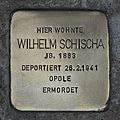
|
HERE LIVED WILHELM SKI DAMAGE JG. 1883 DEPORTED 02.26.1941 OPOLE MURDERED |
Kaiserbrunngasse 17 |
Wilhelm Schischa was born on October 11, 1883 in Gloggnitz . He met his future wife Johanna, née Friedmann, whom he married in 1908, at a Purim ball . Wilhelm was a master tailor and he opened a men's clothing store at Domplatz 3 in Wiener Neustadt. In 1914 they became parents of a son - Eduard, and in 1927 their daughter Karoline followed. The family lived in a house with a garden at Kaiserbrunngasse 17 in Wiener Neustadt. Eduard also trained as a tailor and helped in his father's business. After the annexation of Austria in 1938, the family lost the business and it was Aryanized . On November 10, Wilhelm Schischa was the victim of the large wave of arrests in Wiener Neustadt. SA men searched the family's house and took all valuables with them. Wilhelm and his family were never allowed to enter their house again. Meanwhile, his wife Johanna and the children were taken to the synagogue, where other Jewish women and children from Wiener Neustadt and the surrounding area were also staying. Wilhelm Schischa was released from the Vienna police prison. The family moved to Vienna at Scheuchgasse 19 in Vienna's 9th district. Wilhelm found work for a short time from September 1940 to February 1941 in an aryanized women's and men's clothing store. Daughter Karoline was brought out of the country to safety on a children's transport. Wilhelm and Johanna also planned to flee, but there was not enough money. On February 26, 1941, Wilhelm and his wife were deported from Vienna to Opole. Wilhelm Schischa did not survive the Shoah .
Son Eduard and daughter Karoline survived. Karoline returned to Vienna and married Max Tauber. |

|
ADOLF SCHLÄNGER JG LIVED HERE . 1882 DEPORTED 20.5.1942 MALY TROSTINEC MURDERED 26.5.1942 |
Martinsgasse 14 |
Adolf Schlänger (originally Schlinger, Schlänger from 1934 in documents) was born on January 29, 1882 in Mattersdorf . His first marriage was to Friederike (Frida), née Rosenzweig (marriage in May 1920). He has three children with her - Irma (born 1921), Erich (born 1922) and Edith (born 1931). Erich died as early as 1930 of septic pneumonia and heart inflammation. The family lived at Rosengasse 15 until the 1930s, from where Adolf ran his scrap iron and scrap metal trade, as well as trading in rags and bones. The couple divorced on December 11, 1934, and the daughters stayed with their mother. In 1937 he married Martha (Marta), née Berger, a midwife. He lived with his new wife in Wiener Neustadt at Martingasse 14. After the annexation of Austria they had to leave Wiener Neustadt. Adolf Schläger last lived in Vienna at Pazmanitengasse 14 in Vienna's 2nd district, probably a collective apartment for Jews. His first wife also had to leave Wiener Neustadt with their children and they lived in Vienna. On May 20, 1942, Adolf Schläger was deported from Vienna to Minsk on Transport 22, Train Da 203. His two daughters were also on this transport. The train reached Minsk on May 26, 1942. With the exception of a few young men who were selected for work, all other people were transported to a forest near the Maly Trostinez extermination camp (Blagovshchina). All were shot in front of a prepared pit. Adolf Schläger and his daughters Edith and Irma Schlinger did not survive the Shoah . |

|
SIGMUND SCHLÄNGER JG LIVED HERE . 1880 DEPORTED 03/12/1941 MURDERED IN OCCUPIED POLAND |
Hauptplatz 15 |
Sigmund Schlinger (according to the registration form Wiener Neustadt) was born on July 14, 1880 in Mattersburg. He was married to Fany Schlinger, nee Daniel, with whom he came to Wiener Neustadt from Sauerbrunn in 1912. Here Sigmund worked at a dairy. Later he opened a general store and eventually also became the owner of the “milk hall” of the Graf Zichy estate leasing in Grübelgasse 4. In the end he was a cellar worker and cooper. He presumably carried out this job at the Mandl wine trading company. During the First World War he was in the Air Force Replacement Company 8. On December 13, 1912, son Max was born. After the annexation of Austria he had to leave his apartment in Wiener Neustadt. Most recently he lived in a collective flat for Jews in Große Stadtgutgasse 28 in Vienna's 2nd district. On March 12, 1941, he and his wife were deported from Vienna to Poland on Transport 5. The transport went to Lagow, Opatow and Kielce. 992 people were deported with this transport, 11 people survived. Sigmund Schlänger and his wife Fany Schlinger did not survive the Shoah .
Son Max became a tailor and left Wiener Neustadt in August 1938 to live in Vienna. Sigmund originally wanted his family to emigrate to Palestine, North America or Brazil. If this were not possible, at least his son Max should be the first to be taken abroad. It is not known whether this succeeded. |

|
PAUL JOHANNES SCHLESINGER JG LIVED HERE . 1874 DEPORTED 1944 AUSCHWITZ MURDERED IN GROSS-ROSEN in 1945 |
Herzog Leopold-Strasse 28 |
Paul Johannes Schlesinger was a trained precision mechanic and later a member of the state parliament and national council, as well as class and freedom fighter and trade unionist. He was born on July 9, 1874 in Vienna, where he got to know the sometimes inhumane working conditions in the large factories and industrial centers, which later led him to membership in the Social Democratic Labor Party. Sent to Wiener Neustadt as the secretary of the metal workers' association in 1911 and appointed chairman of the Baden regional health insurance fund four years earlier, in 1911 Schlesinger was promoted to union representative for the districts of Baden, Mödling and Wiener Neustadt. A wound saved the Social Democrats from being deployed in the First World War. Schlesinger was actively involved in thehistorically significant January strike in 1918 , and three years later he moved into the Lower Austrian state parliament . In March 1926 he moved to the National Council , where he stayed until the Austrian Civil War. Both in 1934 and 1938 he was arrested by the Christian social corporations state . In 1934 he had tostayin the Wöllersdorf detention camp for several months, after his release he wasbanned from staying in Wiener Neustadt. After Hitler came to power in Austria, Schlesinger remained feared by the leading state forces. Schlesinger was arrested several times on suspicion of subversive activities, also on September 1, 1944. 18 days later he was transferred to Auschwitz. Shortly before the end of the war, the prisoners weretransportedto Gross-Rosen for fear of the approaching Soviet troops . It is unclear whether the now over 71-year-old Schlesinger already died on the grueling transport there or only died there. In his honor, an urban residential complex in Wiener Neustadt is named after him, where a marble plaque in honor of the political victim commemorates his memory. A memorial plaque in parliament also commemorates him and eleven other members of the National Council who were killed by the Nazi regime. |

|
EDITH SCHLINGER JG LIVED HERE . 1931 DEPORTED 05/20/1942 MALY TROSTINEC MURDERED 05/26/1942 |
Lederergasse 13 |
Edith Schlinger was born on July 28, 1931 (or 1930, according to a report sent to Yad Vashem by Frieda Schlinger) in Wiener Neustadt. She was the daughter of Adolf (later Schlänger) and Friederike Schlinger. Her father was a scrap iron and metal dealer. She had another sister - Irma and a brother Erich, who died in 1930 of septic pneumonia. Her parents divorced in December 1934, the two sisters stayed with their mother. After the annexation of Austria they had to leave Wiener Neustadt. Edith Schlinger last lived at Haasgasse 10 in Vienna's 2nd district, probably a collective flat for Jews. On May 20, 1942 Edith was deported from Vienna to Minsk on Transport 22, Train Da 203. Her sister Irma and her father Adolf Schlänger were also on the transport. The train reached Minsk on May 26, 1942. With the exception of a few young men who were selected for work, all other people were transported to a forest near the Maly Trostinez extermination camp (Blagovshchina). All were shot in front of a prepared pit. Edith Schlinger, her sister Irma and her father did not survive the Shoah .
Her mother does not seem to have been on the transport. Friederike Schlinger survived, she reported the murder of her daughter to Yad Vashem, at that time (1995) she was living in London. |
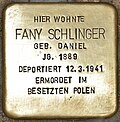
|
HERE LIVED FANNY SCHLINGER GEB. DANIEL JG. 1889 DEPORTED 3/12/1941 MURDERED IN OCCUPIED POLAND |
Hauptplatz 15 |
Fany Schlinger , nee Daniel, was born on November 16, 1869 in Kirchberg am Walde . She was married to Sigmund Schlänger (Schlinger). They came to Wiener Neustadt from Sauerbrunn in 1912. Husband Sigmund first worked in the dairy and eventually opened his own general store. Son Max was born on December 13, 1912. After the annexation of Austria, she had to leave her apartment in Wiener Neustadt. She came to a collective flat for Jews at Große Stadtgutgasse 28 in the 2nd district of Vienna. On March 12, 1941, she and her husband were deported from Vienna to Poland on Transport 5. The transport went to Lagow, Opatow and Kielce. 992 people were deported with this transport, 11 people survived. Fany Schlinger did not survive the Shoah . Sigmund Schlinger's spouse was also murdered.
Son Max became a tailor and left Wiener Neustadt in August 1938 to live in Vienna. Sigmund originally wanted his family to emigrate to Palestine, North America or Brazil. If this were not possible, at least his son Max should be the first to be taken abroad. It is not known whether this succeeded. |
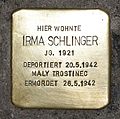
|
IRMA SCHLINGER JG LIVED HERE . 1921 DEPORTED 20.5.1942 MALY TROSTINEC MURDERED 26.5.1942 |
Lederergasse 13 |
Irma Schlinger was born on May 8, 1921 (or 1922 according to a report sent to Yad Vashem by Frieda Schlinger) in Vienna. She was the daughter of Adolf Schlinger (later Schlänger) and Friederike Schlinger. Her father was a scrap iron and metal dealer. She had another sister - Edith and a brother Erich, who died in 1930 of septic pneumonia. Her parents divorced in December 1934, the two sisters stayed with their mother. After the annexation of Austria they had to leave Wiener Neustadt. Irma Schlinger last lived in Im Werd 4 in Vienna's 2nd district, probably a collective flat for Jews. On May 20, 1942, Irma was deported from Vienna to Minsk on Transport 22, Train Da 203. Her sister Edith and her father Adolf Schlänger were also in the transport. The train reached Minsk on May 26, 1942. With the exception of a few young men who were selected for work, all other people were transported to a forest near the Maly Trostinez extermination camp (Blagovshchina). All were shot in front of a prepared pit. Irma Schlinger, her sister Edith and her father did not survive the Shoah .
Her mother does not seem to have been on the transport. Friederike Schlinger survived, she reported the murder of her daughter to Yad Vashem, at that time (1995) she was living in London. |
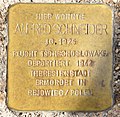
|
ALFRED SCHNEIDER JG LIVED HERE . 1925 ESCAPE CZECHOSLOVAKIA DEPORTED 1942 THERESIENSTADT MURDERED IN REJOWIEC / POLAND |
Raugasse 4 |
Alfred Max Schneider was born in Vienna on August 26, 1925. He was the son of Ernst and Helena Schneider. His father was an electrical merchant and worked as a civil servant in the war grain company. In 1930 the family moved from Vienna to Wiener Neustadt. Alfred fled with his parents in 1938 to Brno, the city of his father's birth. On March 31, 1942, Alfred Max and his parents were deported from Brno to the Theresienstadt concentration camp on Transport Af (his number on the transport was 516). On April 18, 1942, Alfred and his parents were transferred to Rejowiec on Transport Ap (his number on the transport was 206). This transport consisted of 997 people, only three people survived. Alfred Max Schneider and his parents were murdered in Rejowiec. |
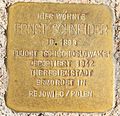
|
ERNST SCHNEIDER JG LIVED HERE . 1893 ESCAPE CZECHOSLOVAKIA DEPORTED 1942 THERESIENSTADT MURDERED IN REJOWIEC / POLAND |
Raugasse 4 |
Ernst Schneider was born on March 1st, 1893 in Brno. He was a businessman and married to Helena Schneider. The couple had a son - Alfred Max (born 1925). Ernst and his wife originally came from Czechoslovakia, first moved to Vienna in the 20th district of Vienna and in 1930 finally to Wiener Neustadt. Ernst Schneider had graduated from business academy and also attended a school for electrical engineering. He was also educated on a musical level, he played the cello and piano. He worked as an electrical merchant, in the textile industry and was an official of the war grain society . Ernst Schneider tried unsuccessfully to leave the Israelitische Kultusgemeinschaft in 1938. He fled to Brno with his family in 1938. On March 31, 1942, Ernst was deported with his wife and son on Transport Af from Brno to the Theresienstadt concentration camp (his number on the transport was 514). On April 18, 1942, Ernst was transferred to Rejowiec with his wife and child on Transport Ap (his number on the transport was 204). This transport consisted of 997 people, only three people survived. Ernst Schneider and his closest relatives, wife and son, were murdered. |

|
HERE LIVED HELENA HELLA SCHNEIDER JG. 1895 ESCAPE CZECHOSLOVAKIA DEPORTED 1942 THERESIENSTADT MURDERED IN REJOWIEC / POLAND |
Raugasse 4 |
Helena Hella Schneider was born on April 4, 1895 in Stanislau. She was married to Ernst Schneider. The couple had a son - Alfred Max (born 1925). Helena and Ernst first moved to Vienna in the 20th district of Vienna and in 1930 finally to Wiener Neustadt. Ernst worked as an electrical merchant, in the textile industry and was an official of the war grain society. Ernst Schneider tried to leave the Israelitische Kultusgemeinschaft in 1938, describing his wife as an “accountant capable of accounting”, “independent correspondent” and “perfect cook”. The efforts at the IKG were unsuccessful. The family fled to Brno in 1938. On March 31, 1942, Helena was deported with her husband and son on Transport Af from Brno to the Theresienstadt concentration camp (her number on the transport was 515). On April 18, 1942, Helena with her husband and son was transferred to Rejowiec on Transport Ap (her number on the transport was 205). This transport consisted of 997 people, only three people survived. Helena Hella Schneider and her closest relatives, husband and son, were murdered. |
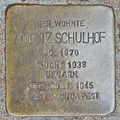
|
HERE LIVED MORITZ SCHOOLYARD JG. 1876 ESCAPE 1938 HUNGARY MURDERED 1945 GHETTO BUDAPEST |
Schlögelgasse 3 |
Moritz Schulhof was born in Hungary in 1876. He was a slaughterer and chief cantor of the Israelitische Kultusgemeinschaft Wiener Neustadt. He was married to Esther Schulhof, a hide and skin dealer. The couple had at least two children - Helene (born 1924) and Bernhard. In 1938 he fled to Hungary. Moritz Schulhof was murdered in the ghetto in Budapest.
His wife Esther survived; she reported to Yad Vashem . Son Bernhard fled to the USA. |

|
ANNA SCHWARZ SR LIVED HERE . ANNA CAROLINE JG. 1876 INSTRUCTED HEILANSTALT WALL Oehling 1935 'THREADS' CASTLE HARTHEIM MURDERED 07/08/1941 |
Wiener Strasse 65 |
Anna Schwarz was born on June 22, 1876 in the parish of Hollenthon . In 1900 she was consecrated as nun Anna Caroline at the Sta. Christiana in Frohsdorf (Lanzenkirchen municipality). Due to persistent paranoia , Schwarz was initially admitted to the Am Spiegelgrund institution in 1928 , later she was transferred to the Mauer-Öhling sanatorium, where she lived until she was deported on August 7, 1941, with interruptions from 1932–1935. A medical commission found her life to be “worthless” in the context of Action T4 , which should ultimately lead to her murder. Because of her intellectual disability, she was murdered in the gas chamber at Hartheim Castle with at least 58 other people. |

|
ROBERT SCHWEIGER JG LIVED HERE . 1907 INSTRUCTED 1940 HEILANSTALT WALL Oehling 'THREADS' 07/10/1941 CASTLE HARTHEIM MURDERED 07/10/1941 |
Blumengasse 5 |
Robert Schweiger was born on October 11, 1907 in Pöttsching . He lived with his parents in Blumengasse and worked as a locksmith, became unemployed and, because of it, became depressed. After he wanted to commit suicide, he was admitted to the sanatorium “ Am Steinhof ” by the medical officer on June 15, 1932 . On November 19, 1932 he was transferred to Ybbs on the Danube. After the state nursing home was opened in Neudörfl, he was transferred there (June 1, 1933). In the meantime he was released, but was re-accepted on December 7, 1937. On June 25, 1940, at the instigation of the Reich governor in Niederdonau, he was transferred to the Mauer-Öhling sanatorium. The last note read "Translated on July 10, 1941 to an institution not mentioned by the management". This note meant a transfer to the Hartheim killing center , where the murder in a gas chamber usually took place on the day the victim arrived. Robert Schweiger was probably murdered here on July 10, 1941. |

|
FRANZ SECKL JG LIVED HERE . 1884 DEPORTED 6.2.1942 RIGA MURDERED |
Kaisersteingasse 7 |
Franz Seckl was the oldest child of Ignaz and Maria Seckl and was born on March 1st, 1884 in Ramplach . He later worked as a businessman. Together with his wife, he was able to enable his two children, Martha and Josef, to go into exile in London. On the seventeenth transport of Jews away from Vienna, one thousand Jews were snatched from their homeland and their lives for each transport, he, like his wife, brother and father, was brought to Riga at the beginning of February 1942, where he was murdered. |

|
HERE LIVED HANNI DOLPHINS Seckl GEB. GRÜNFELD JG. 1886 DEPORTED 6.2.1942 RIGA MURDERED |
Kaisersteingasse 7 |
Hanni Delfine Seckl was born as Hanni Delfine Grünfeld on August 10, 1886 in Velka , later married Franz Seckl, the son of Ignaz Seckl, and was arrested by the Gestapo "because of the provocative behavior of the Aryan population" after she had already arrested by the SS on November 9, 1938, shortly before the pogroms , but was soon released again. She was able to enable her two children, Martha and Josef, to travel to England. She herself died, as did her husband, her brother-in-law and her father-in-law, in Riga , where she was deported on February 6, 1942. |

|
HEINRICH SECKL JG LIVED HERE . DEPORTED 1891 1942 RIGA MURDERED |
Brunner Street 30 |
Heinrich Seckl was born on December 8, 1891 in Wiener Neustadt, the son of Ignaz and Maria Seckl, and worked as a dental technician in Leipzig . Shortly before the start of the war , Heinrich moved back to his hometown Wr. Neustadt and lived there with his father. When SS men arrested parts of his family on November 9, 1938, Heinrich, single for a short time, was not at home. Like his father, brother and sister-in-law, he was deported on February 6, 1942 to Riga , Latvia , where he was killed. |

|
IGNAZ SECKL JG LIVED HERE . DEPORTED 1860 1942 RIGA MURDERED |
Brunner Street 30 |
Ignaz Seckl , born on September 24, 1860 in Bad Fischau , took over a Kleng institute from his father Josef , where he was able to extract seeds from Bockerln and sell them on. His wife Maria died a few years before the Anschluss, after the Jewish merchant no longer received any Bockerl from the surrounding farmers, until then she gave birth to Heinrich and Franz Seckl, as well as Leopoldine Seckl, who "was allowed" to survive the Holocaust due to her Catholic upbringing . The merchant last lived with his son Heinrich on Brunner Strasse in Wiener Neustadt. Like the rest of his family, Ignaz Seckl came to Riga on February 6, 1942, already over 80 years old, where he died. |

|
JOSEFINE SEINFELD JG LIVED HERE . IN 1898 ADMITTED 1932 MURALDAY MAUER-ÖHLING MURDERED 13.3.1941 HARTHEIM CASTLE |
Cathedral Square 12 |
Josefine Seinfeld was born on January 25, 1898 in Wiener Neustadt. She lived with her mother Amalie and her siblings Siegfried and Olga at Domplatz 12. At the instigation of the Wiener Neustadt health department, she was admitted to the Mauer-Öhling sanatorium on July 20, 1931 . On October 24, 1931, he was released on Revers. On August 19, 1932, the health department initiated another induction. The last note read "Translated on March 13, 1941 to an institution not mentioned in the management". This note meant a transfer to the Hartheim killing center , where the murder in a gas chamber usually took place on the day the victim arrived. Josefine Seinfeld was murdered with 15 other patients from Mauer-Öhling on March 13, 1941 in Hartheim.
Her father Max Seinfeld died in 1936. Her sister Olga married Otto Grünwald, and she was also murdered. Mother Amalie had to leave the apartment on Domplatz in the course of the November pogroms and moved away from Wiener Neustadt. Siegfried was most recently enrolled at the Medical Faculty in the 5th semester. After 1938 it was not possible to continue studying. Further whereabouts unclear. |
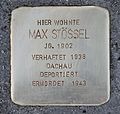
|
HERE LIVED MAX TAPPET JG. IN 1902 ARRESTED IN 1938 DACHAU DEPORTED MURDERED 1943 |
Wiener Strasse 95 |
Max Stössel was born on May 16, 1902 in Wiener Neustadt. He was married to Aloisia and had one son - Julius. His wife ran a bicycle cloakroom (a lockable parking space). In March 1938, the municipality withdrew her permission to use it because she was married to a Jew. It was implied that she would regain the permit after a divorce. The divorce took place, the permit was refused “at its own discretion”. On June 25, 1938 Max Stössel was deported to Dachau, from where he was transferred to Buchenwald in 1938 or 1939. He should be released so that immediate departure could be proven. Since Max Stössel did not want to leave his family, his ex-wife looked for a travel agency that made a dummy booking. This succeeded. She sent a passport and travel documents to Buchenwald concentration camp and Max Stössel was released to leave the country. Max had to report to the police again and again, eventually he was arrested again. His ex-wife was informed that he would come back to Dachau if he could not prove that he had left the country within a few days. Again she found a travel agency and received exit papers for Shanghai. Max was released and he went to Milan. His son Julius followed him, Aloisia was unable to follow her family due to the outbreak of war and the closure of the borders. Max and Julius came to France by secret routes. There they were interned in the Gurs and Drancy camps. They got to Lyon, where they were picked up by the German police, and Max Stössel was deported to Auschwitz in 1942. His son Julius was deported to Auschwitz in 1944, when he could no longer find his father. Max Stössel had meanwhile been murdered.
Julius was deported to Buchenwald before the Red Army arrived, where he gained his freedom on April 11, 1945 through the prisoners' liberation campaign. |
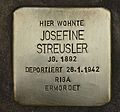
|
HERE LIVED JOSEFINE STREUSLER JG. 1892 DEPORTED 26.1.1942 RIGA MURDERED |
Wassergasse 24 |
Josefine Streusler was born on August 8, 1892 in Wiener Neustadt. Her parents were Hermann Streusler, a tailor from Hungary, and Katharina Frankl. She had two siblings - Gustav and Heinrich. Gustav died in 1919. When her father died in 1927, Heinrich took over the family business. Josefine in turn inherited the house on Wassergasse from her mother, who died in 1936. After the annexation of Austria, the business was aryanized . Her brother and his family, wife Gisela and son Walter, moved in with Josefine in their parents' house. But this was also Aryanized in 1938. Heinrich left Wiener Neustadt with his family. At least one knows about Heinrich that he reached Great Britain. Josefine had to stay in Vienna due to illness. From 1939 there were numerous registration notes for Josefine: March 15, 1939 to April 4, 1940 at Weissgasse 48, then until October 8, 1940 at Roßauer Lände 23A, from October 9, 1940 to July 14, 1941 at Uhdegasse 11, from July 16 to August 18, 1941 again at Weissgasse 48 and finally from August 19, 1941 to January 16, 1942 at Liechtensteinstrasse 103. The last deregistration note finally says: "16.1.42 Poland Action 26.1.42 Riga". Josefine Streusler did not survive the Shoah . |

|
STEFAN SURANYI JG LIVED HERE . 1895 ESCAPE FRANCE INTERNS DRANCY DEPORTED 1944 AUSCHWITZ MURDERED |
Fischauergasse 17 |
Stefan Suranyi (born June 8, 1895 in Szarvas ) came to Wiener Neustadt in 1931 with his wife Valerie and daughter Susanne. At the slaughterhouse in Wiener Neustadt, the trained butcher Suranyi ran a casing cleaning shop together with the Aryan Otto Schneider. A few days after the “Anschluss” he had to leave the operation entirely to his former partner. In the summer of 1938, the family was also evicted from the accommodation and they found shelter with Rosa Wilder, who was also Jewish. Shocked by the “ Reichskristallnacht ”, the Suranyis moved on to Vienna, where they were able to survive for some time with the support of the Israelitische Kultusgemeinde Wien . Although Stefan Suranyi was stateless , he managed to flee temporarily to France in the summer of 1939. However, due to the developments of the World War, people were still not completely safe there: Valerie and Susanne Suranyi were deported to the Auschwitz extermination camp in December 1943, and Stefan Suranyi six months later, and murdered there. |

|
SUSANNE SURANYI JG LIVED HERE . 1925 ESCAPE FRANCE INTERNS DRANCY DEPORTED 1943 AUSCHWITZ MURDERED |
Fischauergasse 17 |
Susanne Suranyi was the daughter of Stefan and Valerie Suranyi. She was born in Baden on April 12, 1925 and attended secondary school for girls in Wiener Neustadt. Like the rest of the family, she had to flee after the November pogroms in November 1938 and later go into exile in France. On December 7, 1943, she was shipped to Auschwitz via Drancy, and there Susanne Suranyi was murdered together with her mother. |
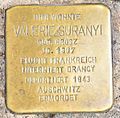
|
HERE LIVED VALERIE Surányi GEB. GROSZ JG. 1897 ESCAPE FRANCE INTERNED DRANCY DEPORTED 1943 AUSCHWITZ MURDERED |
Fischauergasse 17 |
Valerie Suranyi , nee Grosz, was born on September 25, 1897 in Vienna and married her husband Stefan, with whom she had a daughter - Susanne. Since her husband was stateless, it was not until the summer of 1939 that the family managed to flee to France, which had been urgently needed for months, but ultimately not saved. Like the rest of the family, Valerie was deported to Auschwitz on December 7, 1943, where she was murdered six months before her husband, at the same time as her daughter. |

|
JULIANE TAUL JG LIVED HERE . 1921 DISTRIBUTED 12.5.1941 SCHLOSS HARTHEIM MURDERED 12.5.1941 |
Grazer Strasse 95 |
Juliane Taul was born on November 15, 1921 in Wiener Neustadt and deported to Hartheim on May 12, 1941 , where she was murdered on the same day. Juliane was born deaf and has been a half-orphan since 1937. In 1939, her mother and Juliane's siblings moved out of the apartment and left the deaf-mute daughter alone. Due to her incapacity for work, she was brought to Mauer-Öhling on June 1, 1940, where the 19-year-old woman was not able to survive particularly long as a “hereditary disease”: On May 12, 1941, the foster parents were expelled from in with 69 other people the killing facility at Hartheim Castle , where she was murdered by poison gas . Her former home was demolished in the course of the construction of Grazer Strasse in Wiener Neustadt. |
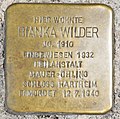
|
BIANKA WILDER JG LIVED HERE . 1910 ADMINISTRATED 1932 HILANSTALT MAUER-ÖHLING SCHLOSS HARTHEIM MURDERED July 12, 1940 |
Fischauergasse 17 |
Bianka Wilder was born on January 2, 1910 in Wiener Neustadt. She lived with her mother Rosa and her two siblings Alfred and Elfriede in their parents' apartment at Fischauer Gasse 17. The father, a doctor, died early. Bianka Wilder stayed briefly in the psychiatric clinic in the Vienna General Hospital (AKH) (November 22, 1932). On November 24, 1932, she was transferred to the “ Am Steinhof ” sanatorium . In the registry log book it was finally noted: "Translated to the Niedernhart-Linz sanatorium on July 12, 1940". The entry means that Bianka Wilder was brought to Hartheim, together with 62 other patients from Mauer-Öhling and murdered with carbon monoxide gas in Hartheim.
Her brother Alfred, a lawyer, died at the front in 1939. Rosa, her mother, was deported to the Łódź ghetto in 1941 and murdered there. Only her sister Elfriede was able to save herself in the USA and survived. |

|
HERE LIVED PINK WILD BORN LANDAU JG. DEPORTED 1877 1941 ŁODZ MURDERED |
Fischauergasse 17 |
Rosa Wilder |
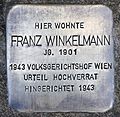
|
FRANZ WINKELMANN JG LIVED HERE . 1901 1943 VOLKSGERICHTSHOF VIENNA JUDGMENT OF HIGH TREASION EXECUTED 1943 |
Purgleitnergasse 46 |
Franz Josef Winkelmann was born on September 6, 1901 in Wiener Neustadt and was a commercial employee. He became involved in a resistance group initiated by Alois Czipek and was executed on October 8, 1943 in Vienna for high treason . The group was particularly active in Ebenfurth , where pro-communist slogans were painted on houses as well as the slogan "Down with the Nazis". Such actions were successful twice: on the 8th anniversary of the February fighting in 1934 , around two thousand leaflets with similar anti-Nazi proclamations were distributed to the residents in Ebenfurth (e.g. "Hitler's downfall is our ascent to freedom"). It took the Gestapo a long time to evacuate the group. Franz Winkelmann was then tortured, tortured and beaten in what was then the Gestapo building in Wiener Neustadt, near the city park. A show trial took place in Vienna on June 1 and 2, 1943, Winkelmann was sentenced to death together with Czipek and five other resistance fighters and beheaded on October 8, 1943. Winkelmann was an illegal member of the NSDAP from 1932 to 1938 , but lost his illusions when Hitler invaded Austria and from then on actively acted against the Nazi system. |

|
ALFRED WÖDL JG LIVED HERE . 1934 DISTRIBUTED 6.2.1941 SANCTUARY AM SPIEGELGRUND MURDERED February 22, 1941 |
Corvinus ring 16 |
Alfred Wödl was born illegitimately on November 25, 1934, the son of Anny Wödl. The boy suffered from the sequelae of smoke gas poisoning that his mother, a nurse at Vienna General Hospital , suffered shortly before the birth. He could hardly speak like that, his legs were too weak to carry him. The child was also repeatedly plagued by joint inflammation . In April 1939 Alfred was separated from his mother and taken to an institution in Gugging . His mother repeatedly campaigned vehemently against the kidnappings of the children, she penetrated twice as far as Herbert Linden , but her efforts were unsuccessful. Therefore, she also had to accept that in 1941 a transfer of her son to the Am Spiegelgrund children's institution was still the comparatively best option for him. On February 22nd of the same year, at the age of 7, the child officially died as a result of "pneumonia". |

|
MARIA WOLF JG LIVED HERE . 1910 DISTRIBUTED 1943 SANITARY INSTITUTE DEPORTED 29.2.1944 MESERITZ-OBRAWALDE MURDERED 7.3.1944 |
Fischauergasse 100 |
Maria Wolf was born on May 28, 1910 in Wiener Neustadt. She lived with her parents at Fischauergasse 100. She stayed several times in sanatoriums, from which she was either released as cured or released into home care. For 1941 and 1942 there was a decree that people who had already been in institutional care had to be referred back to medical officers. Maria Wolf was admitted to Steinhof on November 14, 1941, and on November 19 of the same year she was transferred to Mauer-Öhling. Since space had to be created in Mauer-Öhling for a reserve hospital, almost 300 patients were transferred to Gugging on orders from Berlin on six transports between February 9, 1943 and March 2, 1943. At the beginning of 1944 the Gauleiter jury arranged for Gugging to be evacuated, a hospital of the municipality of Vienna was to be housed here. All the institutions in Austria were now overcrowded. Herbert Linden from the Reich Ministry of the Interior named Meseritz as an alternative. Two transports with 50 women each went to Meseritz on February 28 and 29, 1944. Maria Wolf was on the second transport. The Obrawalde sanatorium was the largest killing station for the mentally handicapped. Patients had to work there until they were completely exhausted and were then killed with drugs. Maria Wolf was murdered here on March 7, 1944. |
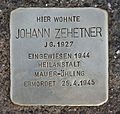
|
HERE LIVED JOHANN ZEHETNER JG. 1927 INSTRUCTED 1944 HEILANSTALT WALL Oehling MURDERED 04/25/1945 |
Burgplatz 1 |
Johann Zehetner was born on October 18, 1927 in Enns and was the older brother of Irma Zehetner and the son of Christine and Johann Zehetner senior, the latter worked in the Theresian Military Academy in Wiener Neustadt as a contract employee, which is why his family has been there since the end of Resided in 1934. At the age of five, the boy was the victim of an accident when he was hit by a motorcycle and subsequently left untreated. This resulted in a development deficit of around three years that Zehetner could no longer catch up. Orphaned and left to himself, Zehetner was transferred to Mauer-Öhling in 1943 after the death of his mother, where he was used for several small jobs. In the files, however, it is described as "of little use". The young man, often described as "calm" or "agreeable", was murdered with electric shocks on April 25, 1945 by the Nazi doctor Emil Gelny , as were 146 fellow prisoners. In the files was tuberculosis specified as a cause of death. |
Other than stumbling blocks
“Stones of Remembrance” - St. Pölten
On October 4, 2018, the first 12 “Stones of Remembrance” were set at 8 addresses in St. Pölten for Jews murdered in the Holocaust. The 18 × 18 cm brass plaques are placed in the sidewalk in front of the last voluntary residential address in the presence of relatives and dependents. Such a plaque with the names of Rudolf and Emma Kohn in Fuhrmannsgasse 15. 575 members of the Jewish community of St. Pölten were murdered in the Holocaust. The first relocation campaign took place on the occasion of 30 years of the Institute for Jewish History in Austria in cooperation with the current house owners and residents and with the participation of Mayor Matthias Stadler (SPÖ) and is to be continued annually.
swell
- Yad Vashem , Database of Holocaust Victims
- DÖW , Documentation Archive of Austrian Resistance
- Holocaust.cz , Czech Holocaust database (German version)
- Stolpersteine.eu , Demnig's website
- Page of the Stolperstein project Wiener Neustadt with biographies
- Werner Sulzgruber : The Jewish community Wiener Neustadt , Mandelbaum Verlag 2005
- Werner Sulzgruber: The Jewish Wiener Neustadt. History and evidence of Jewish life from the 13th to the 20th century , Mandelbaum Verlag 2010
- Werner Sulzgruber: Lifelines. Jewish families and their fates. A biographical journey into the past of Wiener Neustadt , Verlag Berger 2013
- Brigitte Haberstroh , Maximilian Huber , Michael Rosecker (eds.): City guide des Erinnerns , Verein everyday publishing house 2011
- Gerhard Milchram: Holy Community Neunkirchen - A Jewish Home Story , Mandelbaum Verlag 2000
- Roland Burger u. a. (Ed.): Erased - From the life of the Jews in Mödling , Edition Umbruch 1988
See also
Web links
Individual evidence
- ^ Auschwitz-Birkenau State Museum (ed.): Auschwitz death books, Volume 2/3: List of names AZ (reprinted 2012) . De Gruyter, Berlin / Boston 1995, ISBN 3-11-097409-6 , pp. 833 .
- ^ Mödlinger Nachrichten of March 26, 1938, p. 4
- ↑ Accompanying brochure campaign stumbling blocks
- ^ Ferdinand Diamant in the Yad Vashem database , accessed on February 17, 2019
- ↑ Willi Weinert: “You can put me out, but not the fire” - biographies of the resistance fighters executed in the Vienna Regional Court; a guide through group 40 at Vienna's central cemetery and to sacrificial graves in Vienna's cemeteries, Wiener Stern-Verl., Vienna 2011, ISBN 978-3-9502478-2-4 , p. 82
- ↑ Accompanying brochure campaign stumbling blocks
- ↑ Archived copy ( memento of the original from January 30, 2016 in the Internet Archive ) Info: The archive link was inserted automatically and has not yet been checked. Please check the original and archive link according to the instructions and then remove this notice.
- ^ Auschwitz-Birkenau State Museum (ed.): Auschwitz death books, Volume 2/3: List of names AZ (reprinted 2012) . De Gruyter, Berlin / Boston 1995, ISBN 3-11-097409-6 , pp. 860 .
- ↑ Evan Burr Bukey: Jews and Intermarriage in Nazi Austria, p. 67 f., Cambridge 2010
- ↑ doew.at
- ↑ Elza Schwajger in the Yad Vashem database , accessed on February 17, 2019
- ↑ Konrad Taussig in the Yad Vashem database , accessed on February 17, 2019
- ↑ Stefan Eminger (ed.): Lower Austria in the 20th Century: Politics , Vienna, Cologne, Weimar: Böhlau 2008, 487
- ↑ doew.at
- ^ Walter Baumgartner: Jews in Lower Austria. P. 51
- ↑ a b Gerhard Milchram: The Löwis - On the trail of a Jewish family. In: David (Jewish culture magazine). 2000, accessed February 17, 2019 .
- ↑ http://www.lettertothestars.at/liste_ermordete.php?searchterm=simon+l%F6wy&action=search&x=0&y=0 ( page no longer available , search in web archives ) Info: The link was automatically marked as defective. Please check the link according to the instructions and then remove this notice.
- ↑ db.yadvashem.org
- ↑ Max Maier in the Yad Vashem database , accessed on February 17, 2019
- ↑ Helene Reininger in the Yad Vashem database , accessed on February 17, 2019
- ↑ a b c Ruth Contreras in the flyer project Stolpersteine für Pitten ; Publisher: Market town of Pitten; 7th August 2018
- ↑ Anni Stern-Braunberg : In the name of my father. Otto Müller Verlag, Salzburg 1994, ISBN 3-7013-0884-5 .
- ↑ a b Breuer family. In: Stolpersteine Wiener Neustadt. Retrieved February 17, 2019 .
- ↑ Fanny Duhl in the Yad Vashem database , accessed on August 21, 2017
- ↑ Julis Duhl in the Yad Vashem database , accessed on August 21, 2017
- ↑ Details on Transport 39 Zug Da 225 , accessed on August 21, 2017
- ↑ Julius Duhl Biography , accessed on August 21, 2017
- ↑ a b c d Feldmann family. In: Stolpersteine Wiener Neustadt. Retrieved February 17, 2019 .
- ↑ Waltraud Häupl: Traces of the murdered children and young people in Hartheim and Niedernhart . Böhlau, 2012, p. 76 .
- ^ Flossenbürg Concentration Camp Records, 1938–1945
- ↑ zeitgeschichte-wn.at
- ↑ a b Wilhelm and Johanna Schischa. In: Stolpersteine Wiener Neustadt. Retrieved February 17, 2019 .
- ↑ Siegmund Schlaeger in the Yad Vashem database , accessed on February 17, 2019
- ^ Yad Vashem: Edith Schlinger , accessed November 29, 2016.
- ↑ Irma Schlinger in the Yad Vashem database , accessed on February 17, 2019
- ↑ Juliane Taul. In: Stolpersteine Wiener Neustadt. Retrieved February 17, 2019 .
- ↑ Stones remind of Jews murdered in the Holocaust. In: orf.at . October 5, 2018, accessed October 5, 2018.
- ↑ Carina Bauer: Stones of Remembrance for Holocaust Victims. In: orf.at . October 5, 2019, accessed October 5, 2019.

